Rio Aripuana and Rio Madeira Cruise, Brazil: October 2019
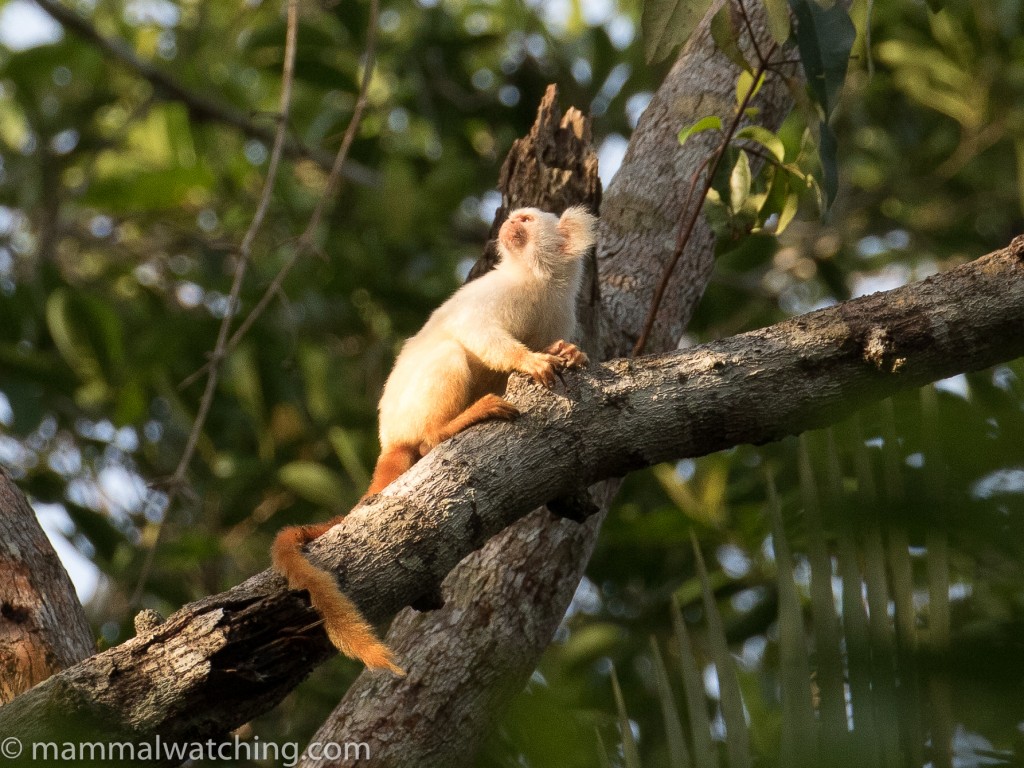
Gold and White Marmoset, Mico chrysoleuco
With Cheryl Antonucci, Jon Hall, Patrick Hall, Morten Joergensen, Stefan Lithner, Marcelo Marcos, Keith Millar, Fiona Reid, Mike Richardson, Micah Riegner, Martin Royle, Lynda Sharpe, Nozomi Takeyabu, Sarah Winch and the crew of the Tumbira.
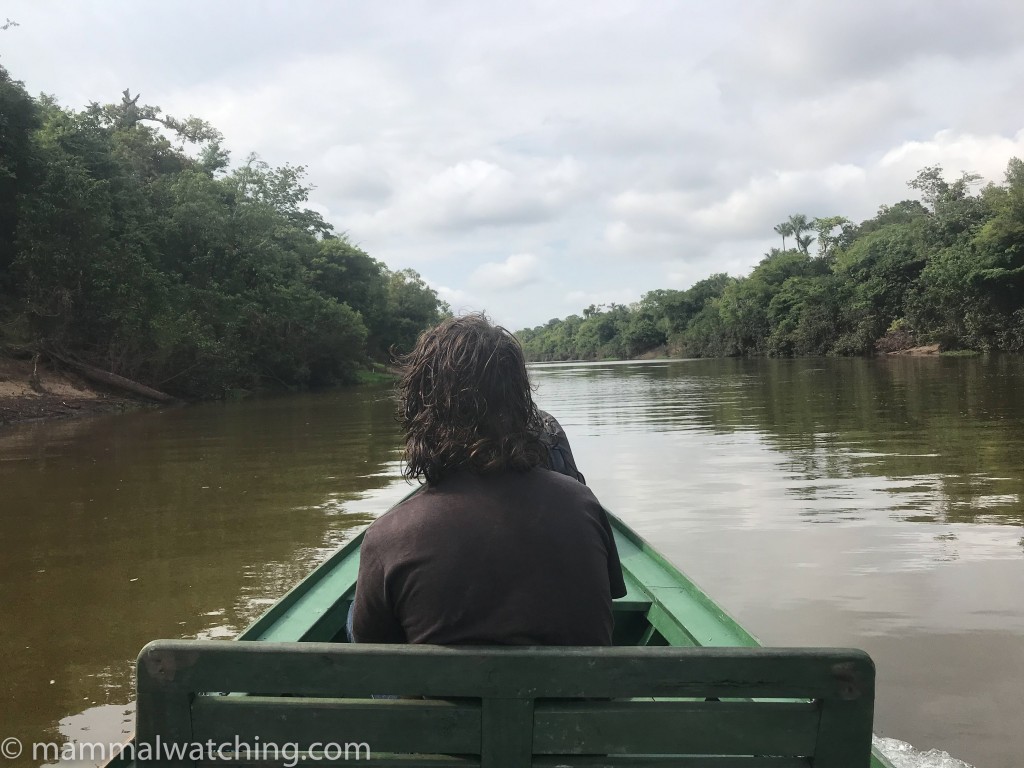
In June 2017 I joined Fiona Reid on a spectacularly successful cruise through the Amazon, alongside Micah Reigner, Marcelo Marcos and Jose Gabriel Martinez. Even before that trip had finished we were keen to get the band back together and began talking about the possibility of heading down the more remote Rio Aripuana in search of some little known mammals including the mysterious Dwarf Manatee (which may or may not be a full species) and the recently described Dwarf Marmoset.
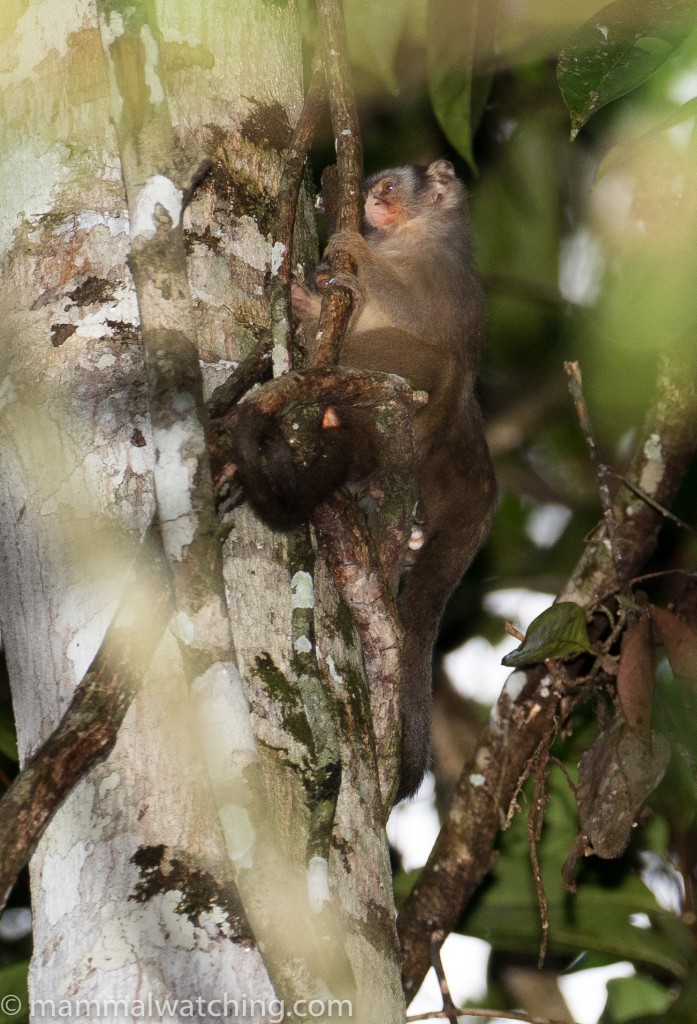
Black-crowned Dwarf Marmoset, Callibella humilis
Micah knows the area well and Field Guides, the tour operator he guides for, were able to arrange the permits we would need to visit the Aripuana. And so a plan was hatched to return to the Amazon in October 2019, at the very end of the dry season, when the Dwarf Manatees congregate in a creek along the Aripuana. Micah would organise and lead the expedition on behalf of Field Guides.
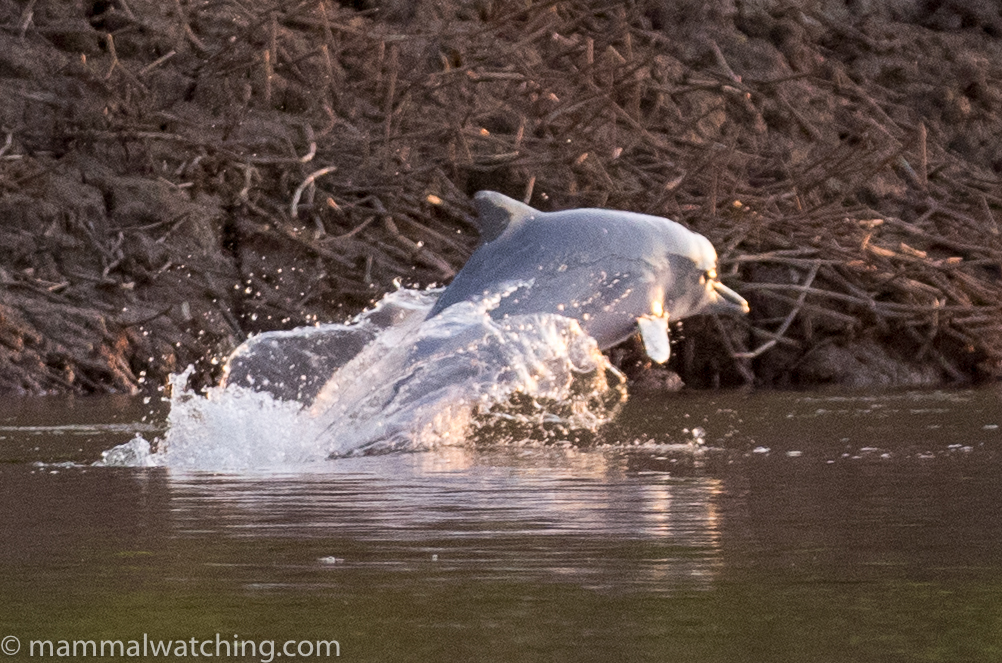
Tucuxi, Sotalia fluviatilis
In June 2017 we saw a remarkable 79 mammal species, travelling when the river was at its highest level, ensuring we could spend a lot of time in canoes searching flooded forest. The trip was planned around reliable sites for the different primates. This trip was rather different. The water was about as low as it gets, at least 20 metres lower than in June, so the forest was inaccessible by canoe. We were also visiting areas further off of the beaten path, where few wildlife tourists had been before, and the mammal watching was harder to predict.
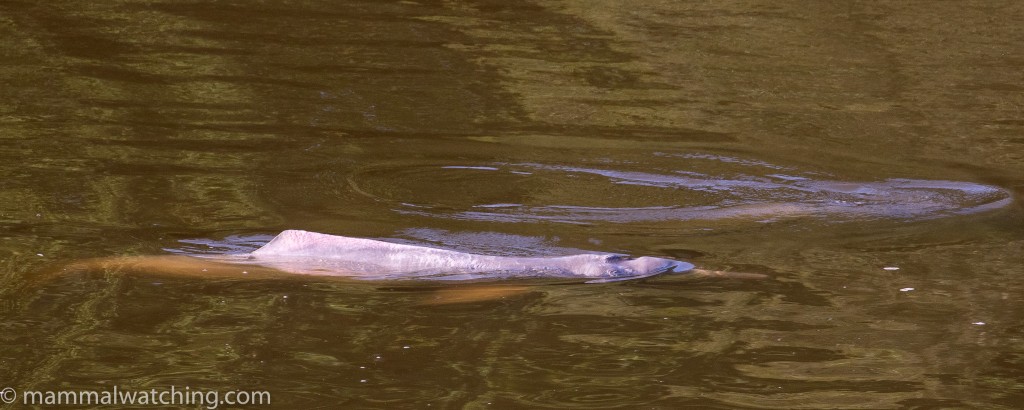
Amazon Pink River Dolphin (or Boto), Inia geoffrensis
In the end this trip suffered more than its fair share of challenges, including unusually low water levels in the river, coupled – ironically – with far more rain than expected. Blame climate change, Bolsonaro or just bad luck, but aspects of the trip did not run as planned. We made the best of it though and ended up recording close to 60 species of mammal, and some notable non-mammals too, even if we missed the Dwarf Manatee, one of our main goals.
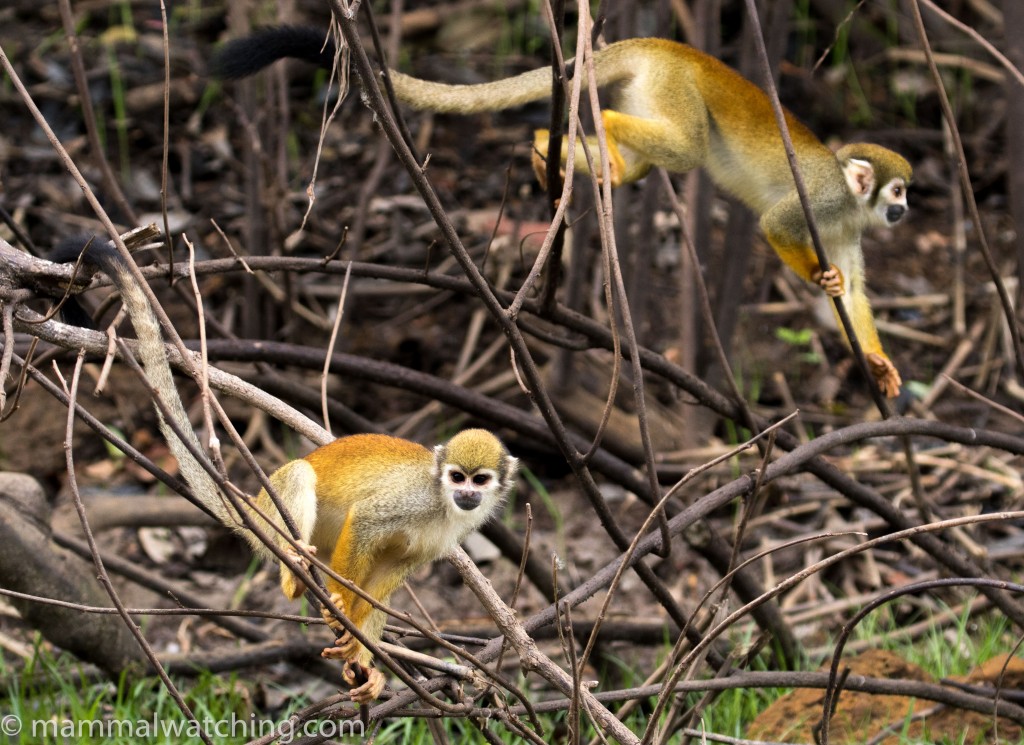
Humboldt’s Squirrel Monkey, Saimiri sciureus cassiquiarensis
Manaus
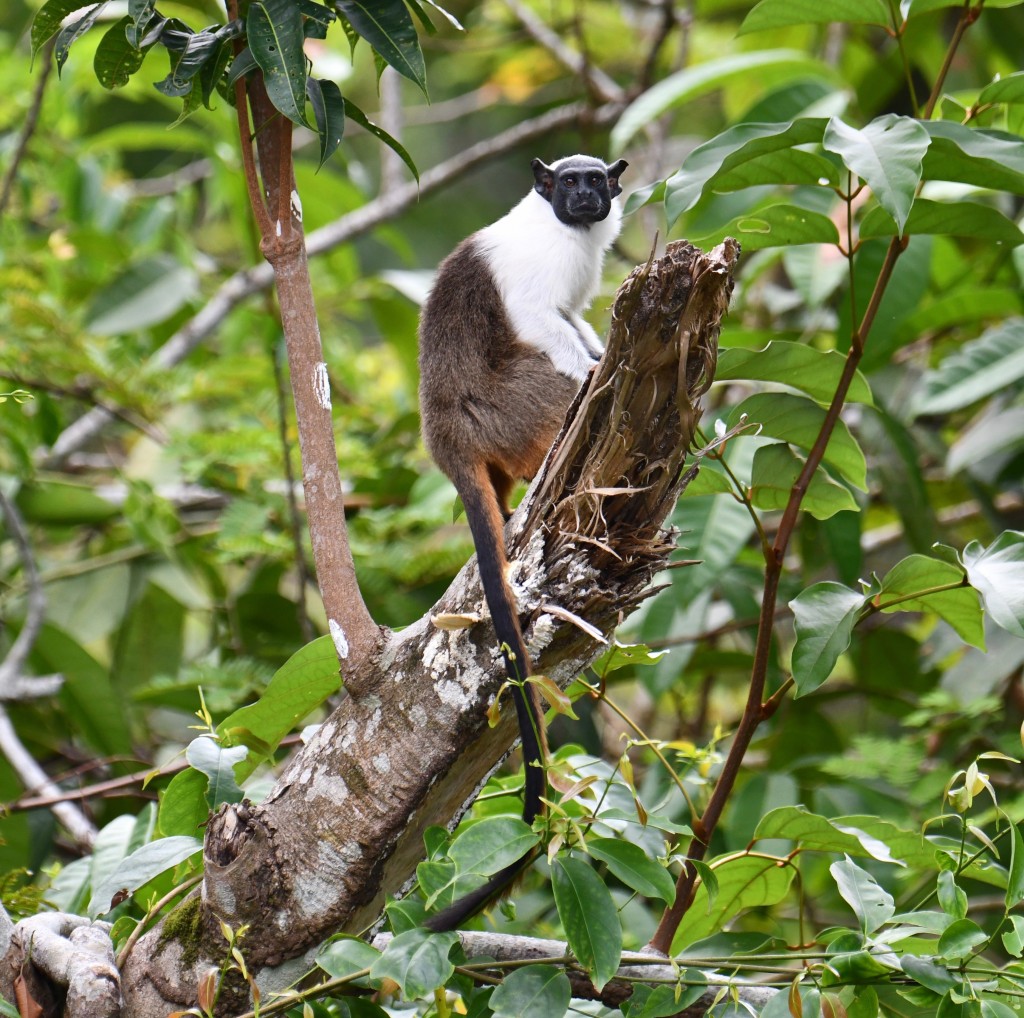
Pied Bare-faced Tamarin, Saguinus bicolor. Photo Cheryl Antonucci
October 3. Most of the group assembled in Manaus the day before the trip began, and visited the observation tower at Reserva Duque and the grounds of the (now abandoned) Tropical Hotel where they saw the beautiful, and very restricted, Pied Bare-faced Tamarins and a Two-toed Sloth.
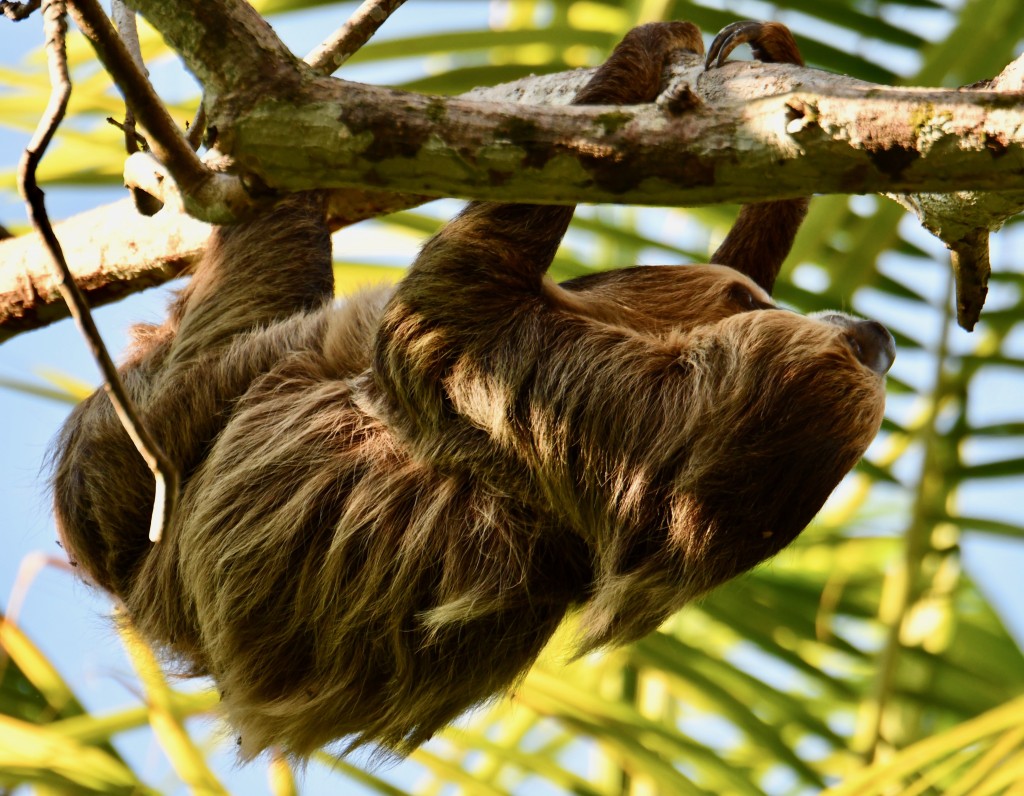
Southern Two-toed Sloth, Choloepus didactylus. Photo Cheryl Antonucci
Rio Aripuana
October 4. The Rio Aripuana is a clearwater river and one of the Amazon basin’s major biogeographic boundaries. It flows into the Rio Madeira at Novo Aripuana. We’d intended to fly from Manaus to Novo Aripuana to meet our boat and home for the next weeks, the Tumbira. But complications with aircraft charter meant we had to switch to a fast (scheduled) speedboat ferry to take the 10 hour ride from Manaus to Novoa Aripuana. We spotted a few river dolphins – both pink and grey – along the way. Both species were a near daily sight for the duration of the trip.
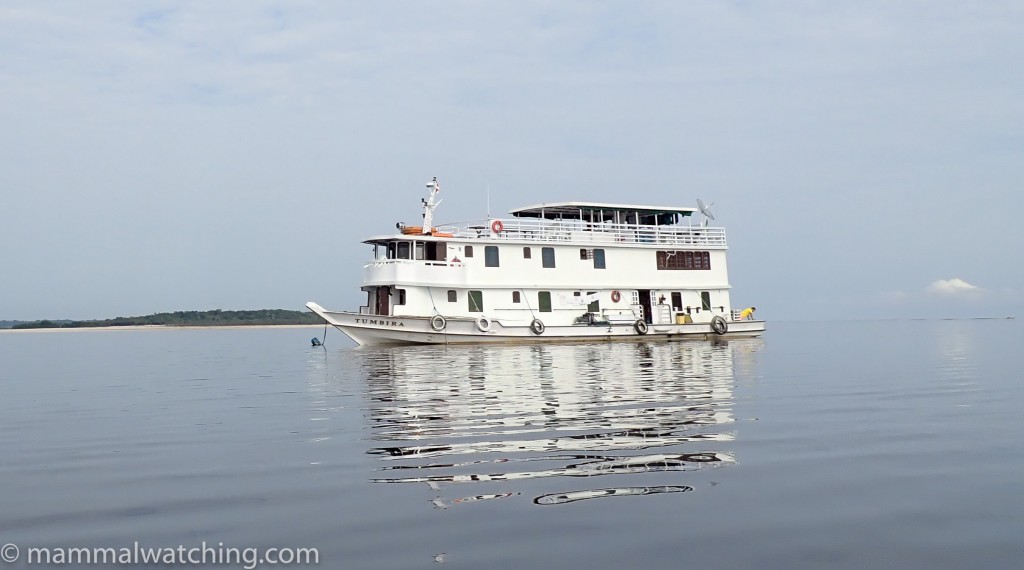
The Tumbira
A short bat catching session that night found Geater Spear-nosed and Silky Short-tailed Bats, though the highlight for most of us was a superb Surinam Horned Frog that Fiona caught by hand. We settled into our cost cabins and started cruising up the Aripuana.
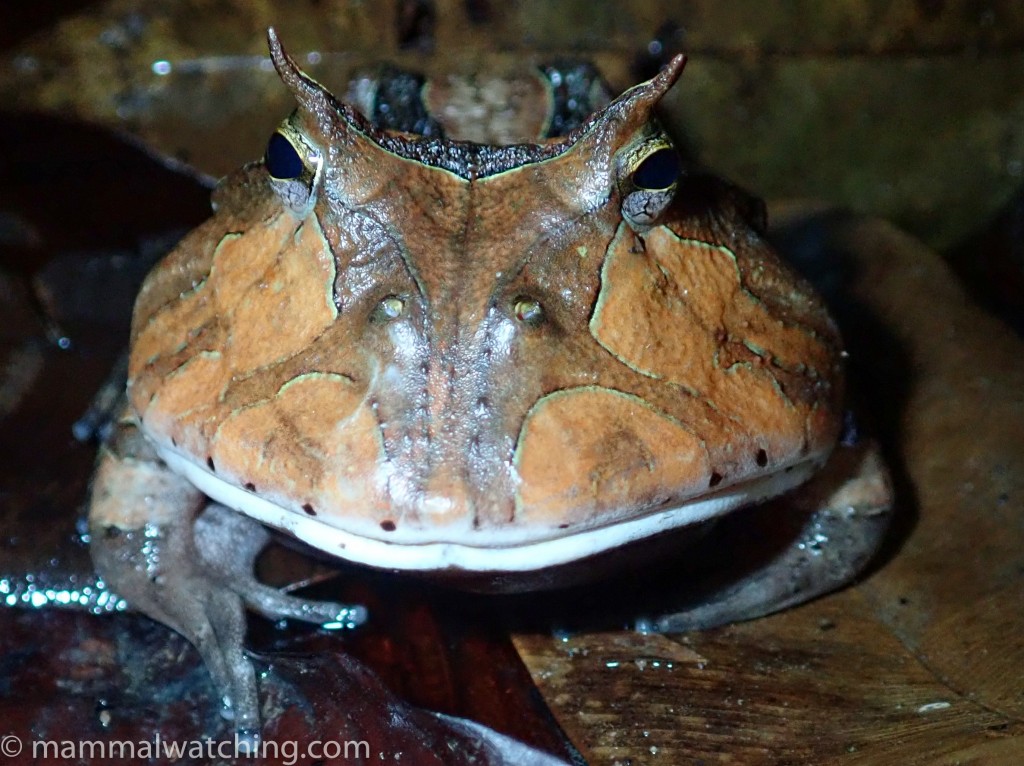
Suriname Horned Frog
5 October. We had arrived before dawn at the small community of Nova Olinda, somewhere near here, where primatologist Marc van Roosmalen spent several months.
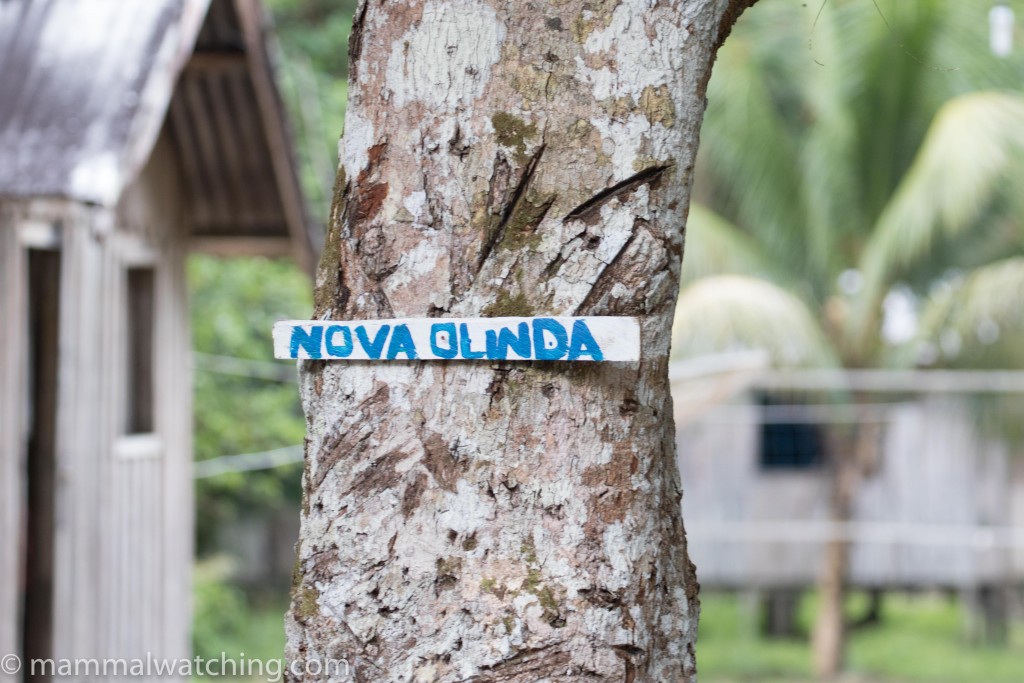
Three important primates live close to the village and we got off to a flying start seeing all of them that morning, with very good views of the Dwarf Marmoset, a species which Roosmalen described only in the late 1990s and we may have been the first tour group to see it. Some also saw Prince Bernhard’s Tit Monkey, Golden-backed Squirrel Monkeys and Marca’s (Manicore) Marmoset that morning (there is some debate about the taxonomy of this species but I will follow the IUCN to treat Manicore Marmoset as synonymous with Marca’s Marmoset).
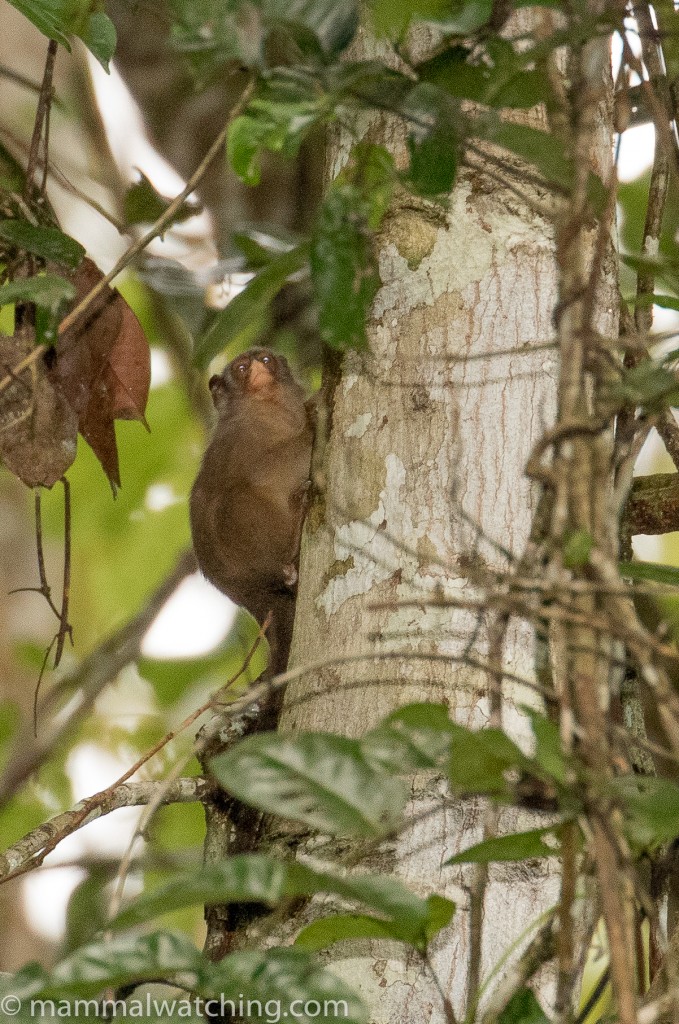
Black-crowned Dwarf Marmoset, Calibella humilis
Fiona and Marcelo were able to identify three bat species roosting along the trail, two were inside hollow logs, while a small group were hanging under a palm frond.
This is Baker’s Long-tongued Bat, which in 2021 was split from Commisari’s Long-tonged Bat that we originally recorded it as.
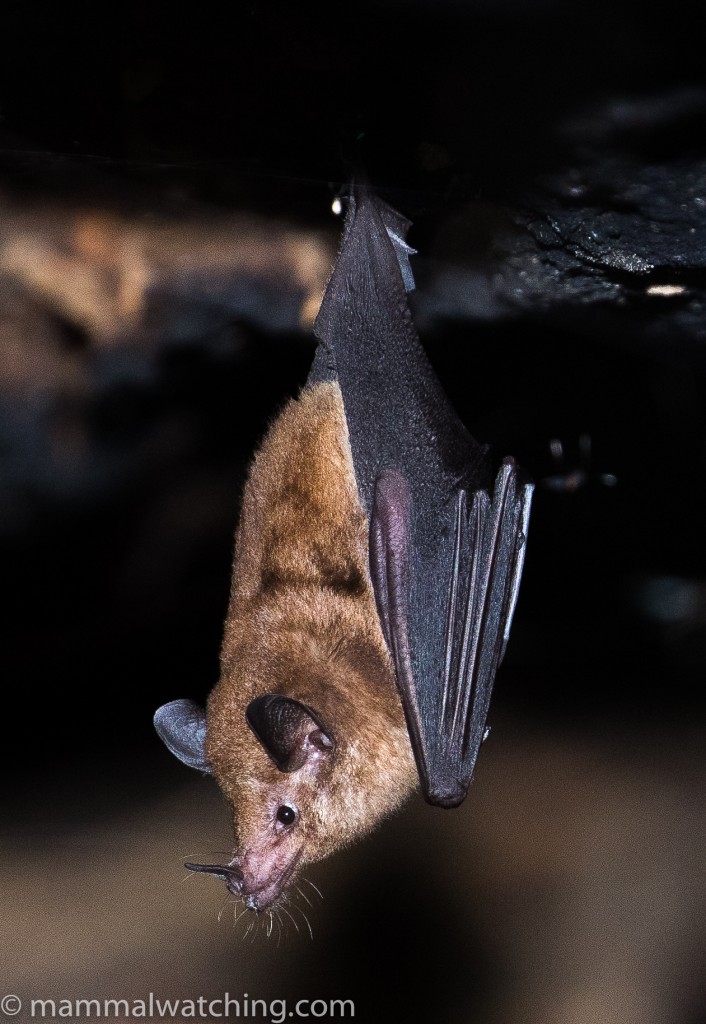
Baker’s Long-tongued bat, Glossophaga bakeri
This is a Greater Dog-like Bat.
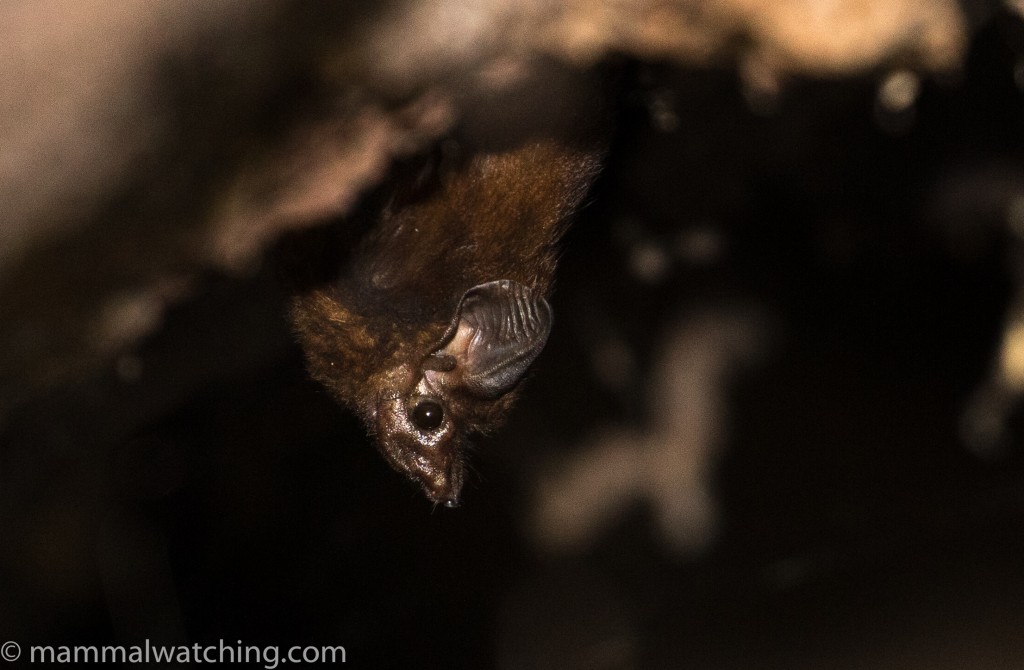
Greater Dog-like Bat, Peropteryx kappleri
And these guys are Common Tent-making Bats.
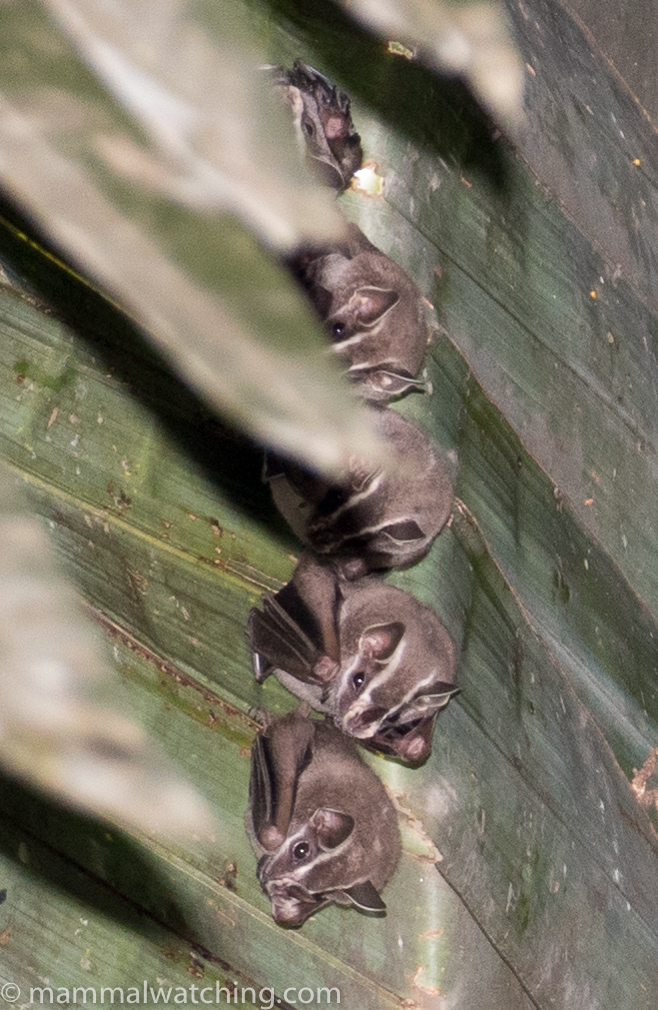
Common Tent-making Bat, Uroderma bilobatum
In the afternoon we motored further upstream to a logging road at Prainha, where an afternoon walk was largely – actually make that totally – mammal-free. Spotlighting along the road produced a young Common Opossum and a Bare-tailed Woolly Opossum.
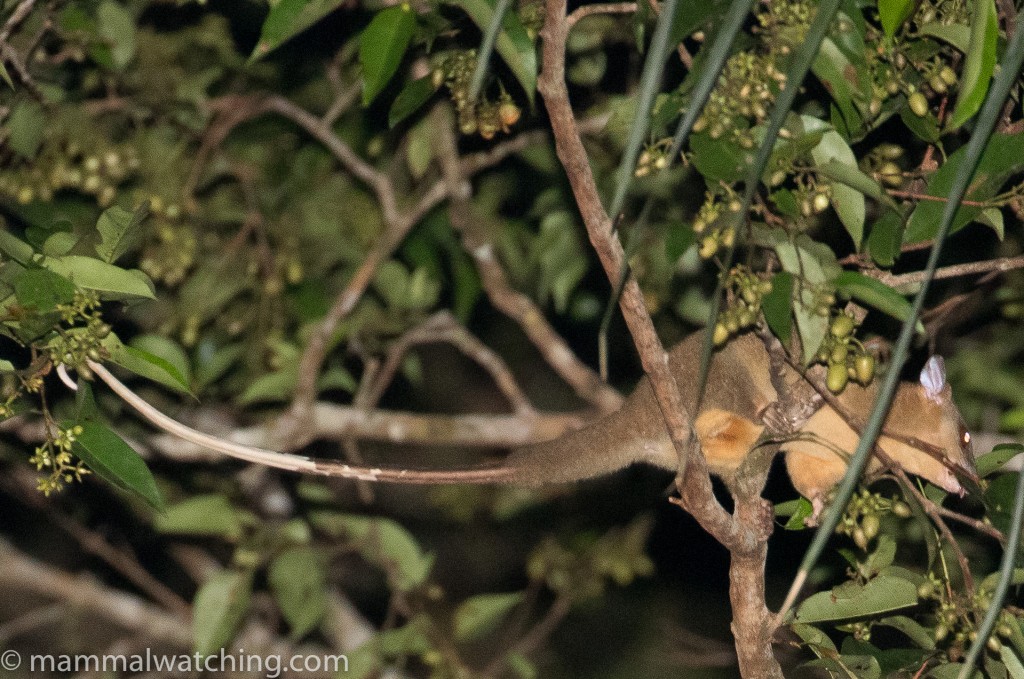
Bare-tailed Woolly Opossum, Caluromys philander
Even I was impressed with this Spectacled Owl.
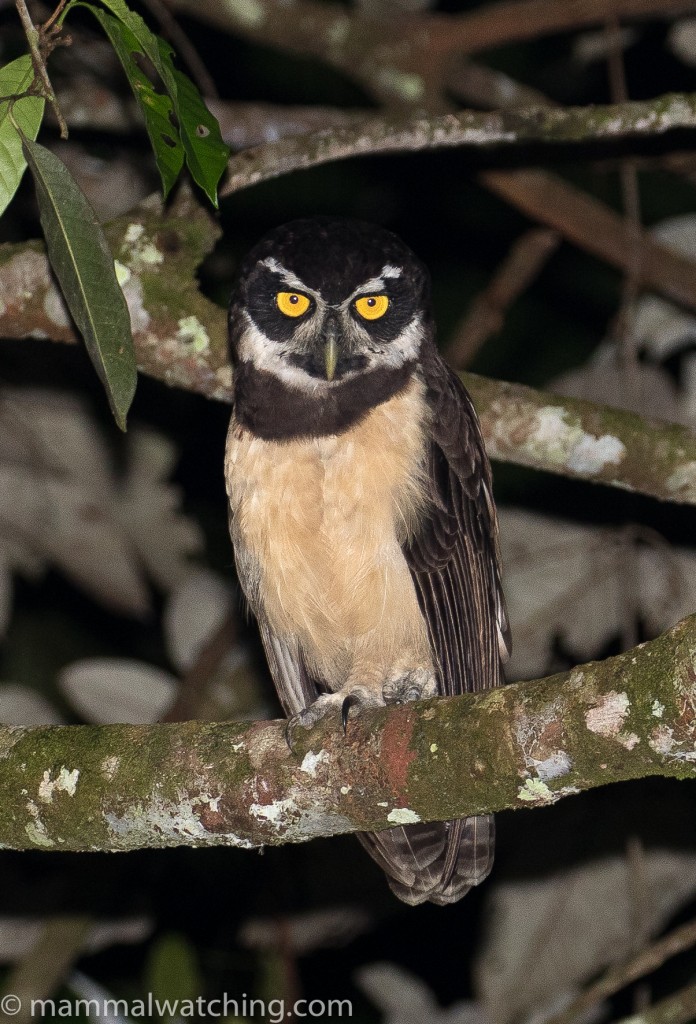
Spectacled Owl
6 October. We walked the road at Prainha again but the mammals were still relatively thin on the ground, at least compared to the June 2017 Amazon trip. Partly this seems to be a characteristic of the clearwater of the Aripuana. Partly because of the need to walk, rather than canoe, through the forest this time of year. And partly – and this is just a hunch – because of hunting pressure in the areas we visited. Outside of Nova Olinda many primates seemed skittish in ways they were not on the last trip. Micah for instance, got a fleeting glimpse of a Grey Woolly Monkey this morning (a heavily hunted primate that was high on my wish list) while we were walking a road, but it bolted at first sight. That said most of the group got reasonable views of gorgeous Gold and White Marmosets this morning.
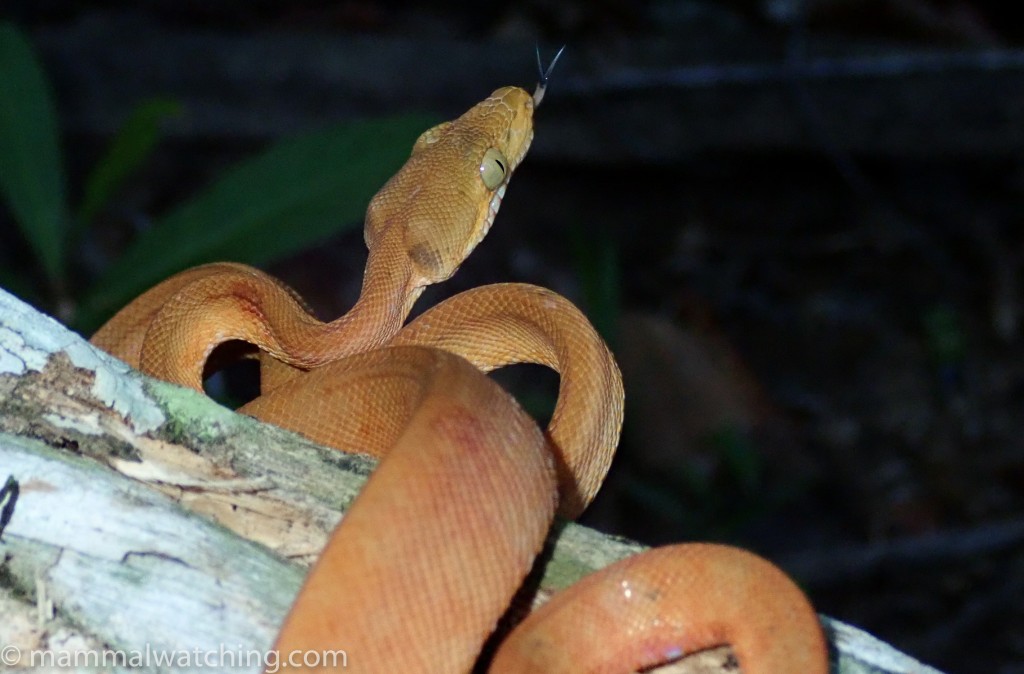
Amazon Tree Boa
We had intended to get several hours further upstream that afternoon so we could start in the canoes the next morning for an all day expedition along the clearwater creek where the manatees gather at this time of year. But our journey upriver came to an abrupt halt not far from Prainha when we encountered a sandbank blocking the river: a week earlier the water had been 3 meters higher! This presented a serious spanner in the works for our plans to look for the manatee. The creek was at least a six hour canoe ride away from here. And, with nowhere but the boat to sleep, it looked like it would be impossible to make it there and back in a day.
Batting that night was quiet with a few Dark Fruit-eating Bats and a rather uncommon Chestnut Sac-winged Bat.
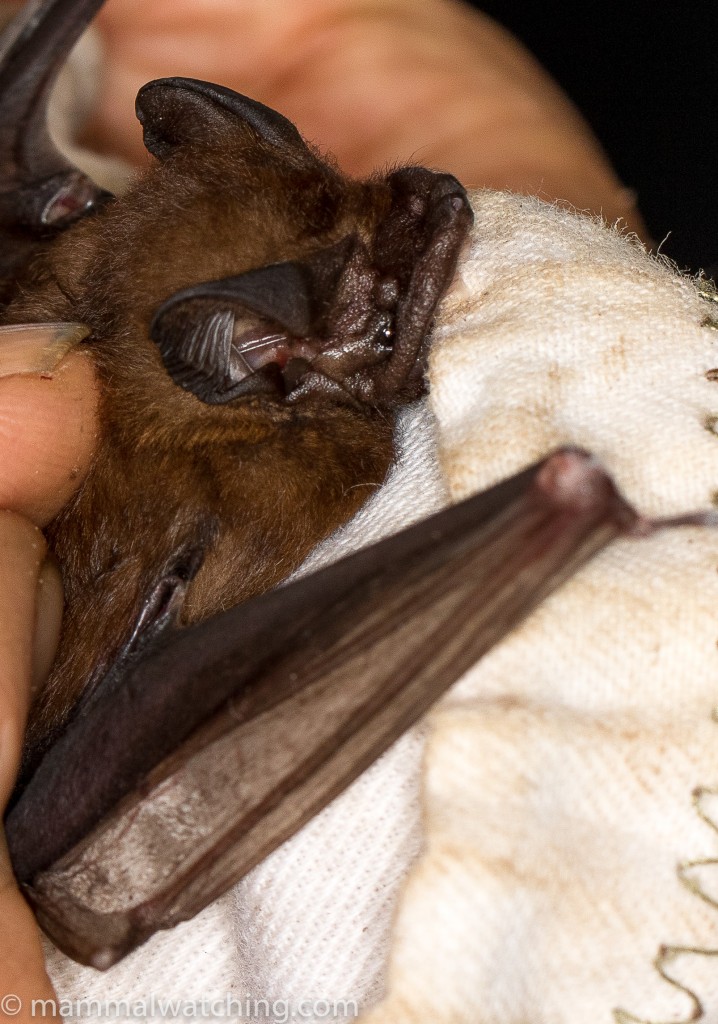
Chestnut Sac-winged Bat, Cormura brevirostris
7 October. The next morning we set off in the canoes. Though the manatee creek was indeed out of range, another 3 hours or so upriver would get us into an area where Frances, one of the local guides, had occasionally seen larger manatees.
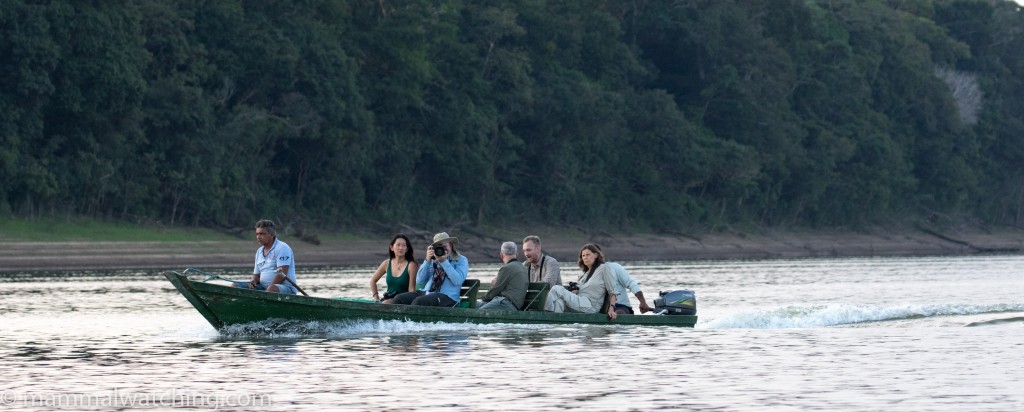
A Harpy Eagle was, for many, the highlight of the morning, and a group of Proboscis Bats roosting on a tree, along with river dolphins, were the only mammals of the morning.
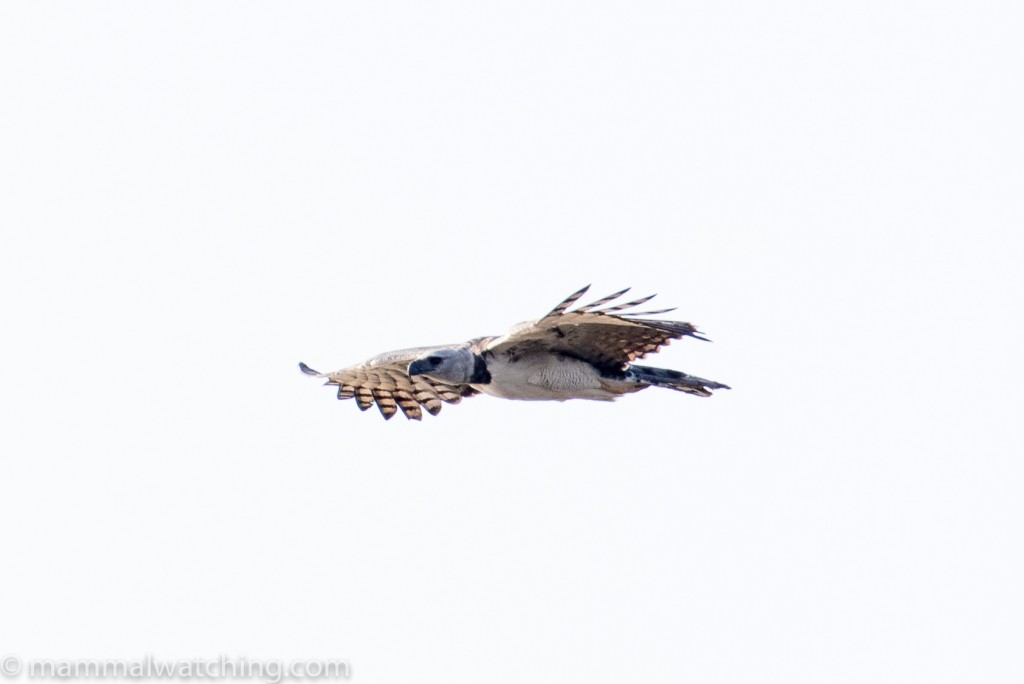
Harpy Eagle
By 11 a.m. it was stinking hot and we collapsed into the shade at a small fishing hotel at Boca do Juma. With hindsight we realized that, if we had spent the night here, we would have been within striking distance of the manatee creek. But hindsight is a wonderful thing and the hotel was full. So we spent the day trying to avoid the heat and staking out a deep pool in the fairly slim hope that a manatee would surface. It didn’t though they had been seen in the area quite recently.
The temperature dropped around 4 p.m. and a short walk around the lodge produced some Golden-backed (Bare-eared) Squirrel Monkeys and Brown Capuchins (Spajus apella).
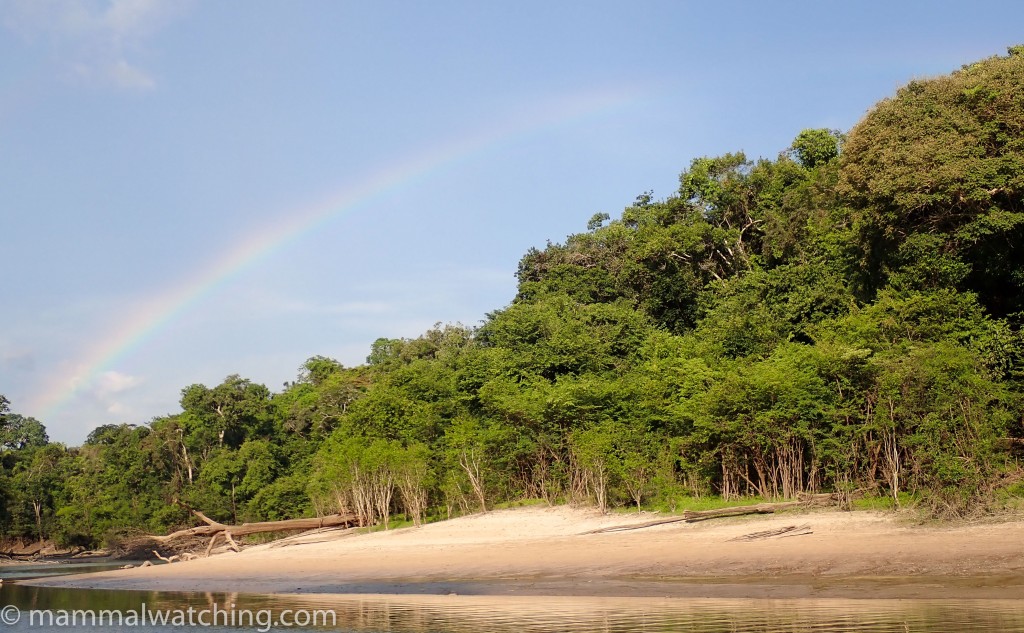
We got into the canoes at 5 p.m. for the long ride back to the boat and the gathering storm clouds gathered very quickly. Most of the trip back was in torrential rain, with a massive lightning storm lighting our way and – sometimes – striking trees directly opposite the boat. Like many I spent the best part of two hours trying to calculate whether our chances of not being struck by lightning would improve nearer to the bank or out in the middle of the river.
But we – and our cameras – were all still functioning when we got back to the boat well after dark. There was no prospect of wildlife watching or bat catching in the rain so we got stuck into the caipirinhas, as the crew prepared to return back down the Aripuana.
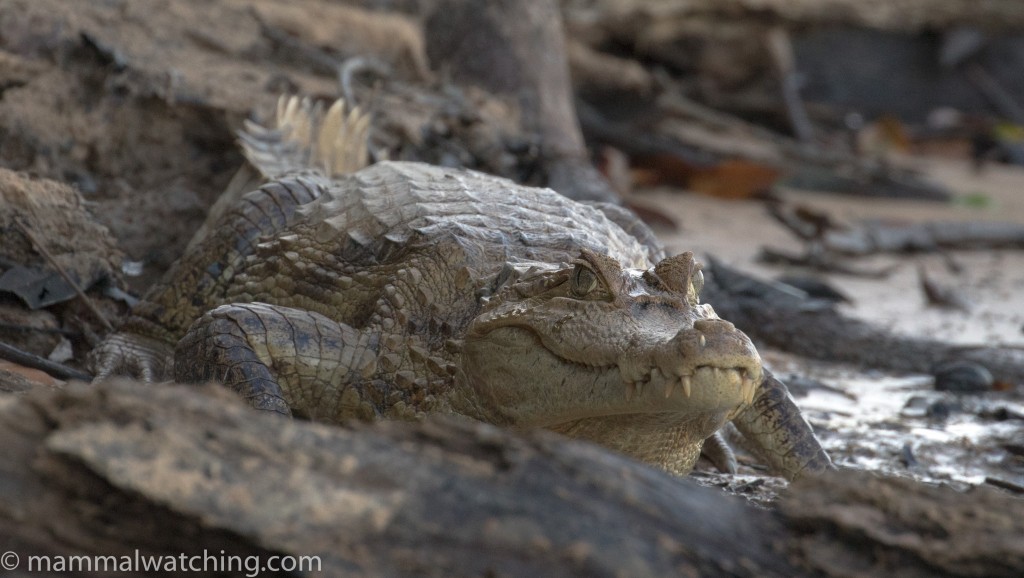
Black Caiman
8 October. We spent the morning on the east (right) bank of the Aripuana across from Nova Olinda. A long walk produced some brief views of White and Gold Marmosets and Ashy Grey Titi Monkeys and a some saw a tiny Neotropical Pygmy Squirrel. Heavy rain that afternoon ruled out more time in the field and so the crew put on a superb barbecue, while Marcelo managed to put up some nets and catch an interesting bat: a Short-headed Broad-nosed Bat, a lifer for me.
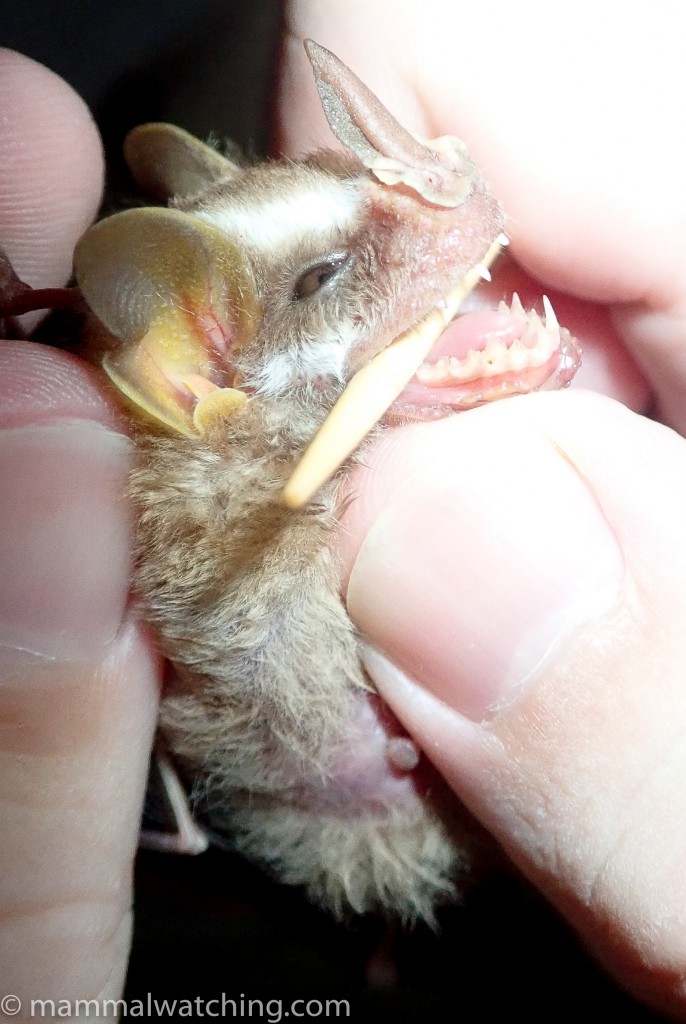
Short-headed Broad-nosed Bat, Platyrrhinus brachycephalus
9 October. The following morning we were back to Nova Olinda before sunrise to try again for the Prince Bernhard Titi Monkeys and the Marca’s Marmosets that most of us had seen poorly a few days earlier. This was one of the best mammal mornings of the trip so it was unfortunate that several of the group were sick and had opted to stay on the boat.
We saw a Black Agouti at sunrise on the edge of the community’s football pitch and heard titis calling shortly afterwards.
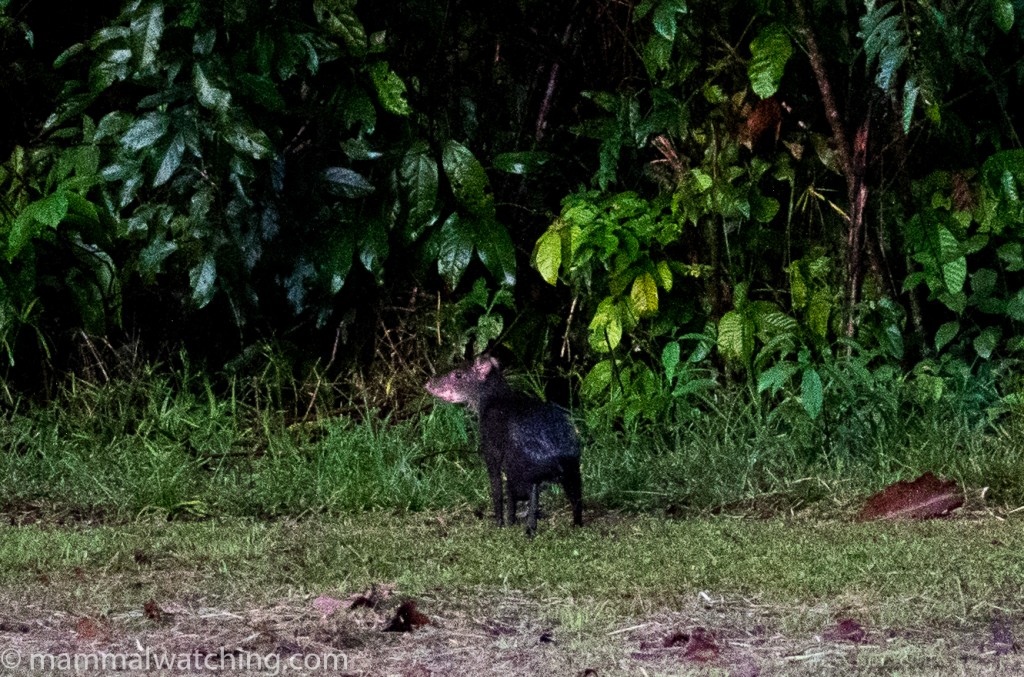
Black Agouti, Dasyprocta fuliginosa
After getting a good look, in terrible light, at a group of Prince Bernhard Titis, an animal posed briefly in a sunlit clearing.
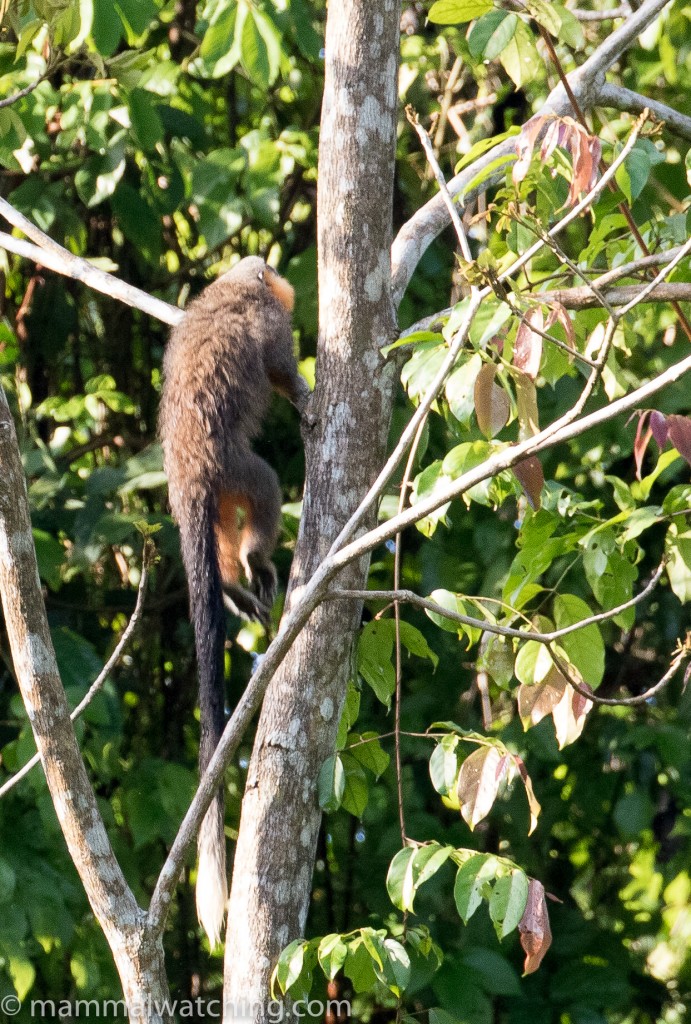
Prince Bernhard’s Titi, Plecturocebus bernhardi
Ssoon afterwards we had excellent views of several Marca’s Marmosets.
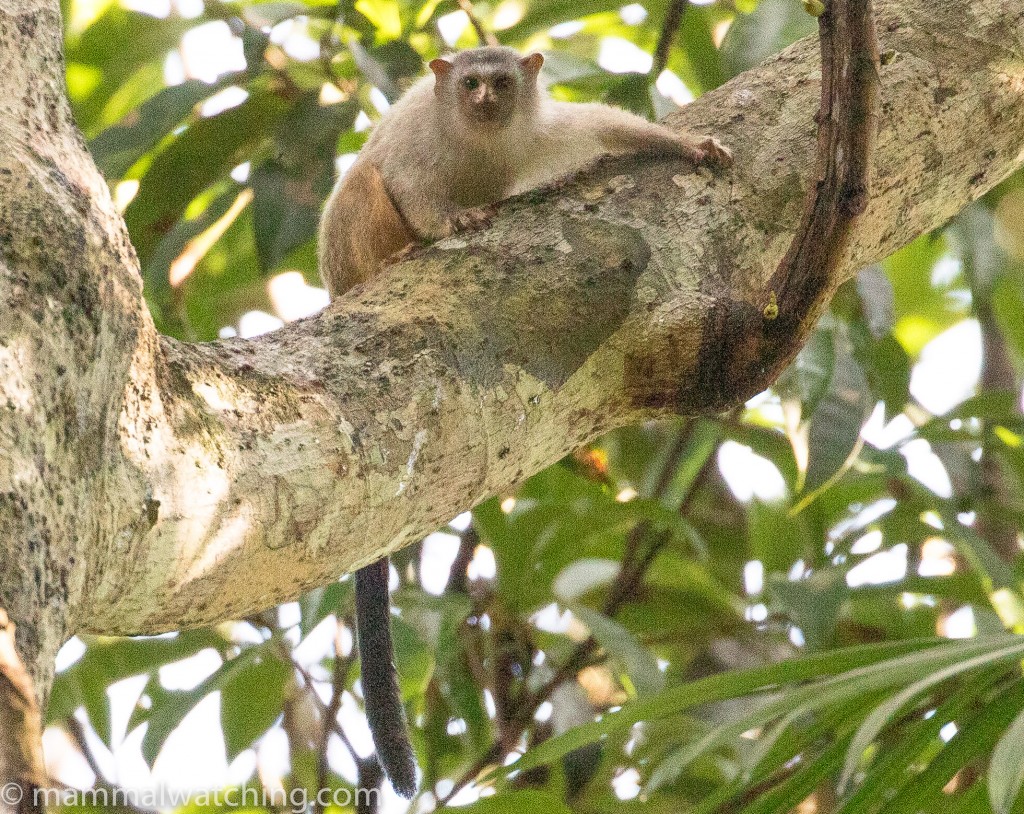
Marca’s Marmoset, Mico marcai
A few Brown Capuchins added to the morning’s haul, though Micah was the only one of us quick enough to spot some shy Red-nosed Bearded Sakis.
Nova Olinda aside, the Aripuana had been quite disappointing and so we decided to move on to the more wildlife rich Rio Madeira earlier than scheduled.
More rain meant the afternoon’s highlight was ice cream in Nova Aripuana, though the batting that evening was quite good, with several species including Brown Tent Making Bat, Flat-faced Fruit-eating Bat, a Stripe-headed Round-eared Bat,
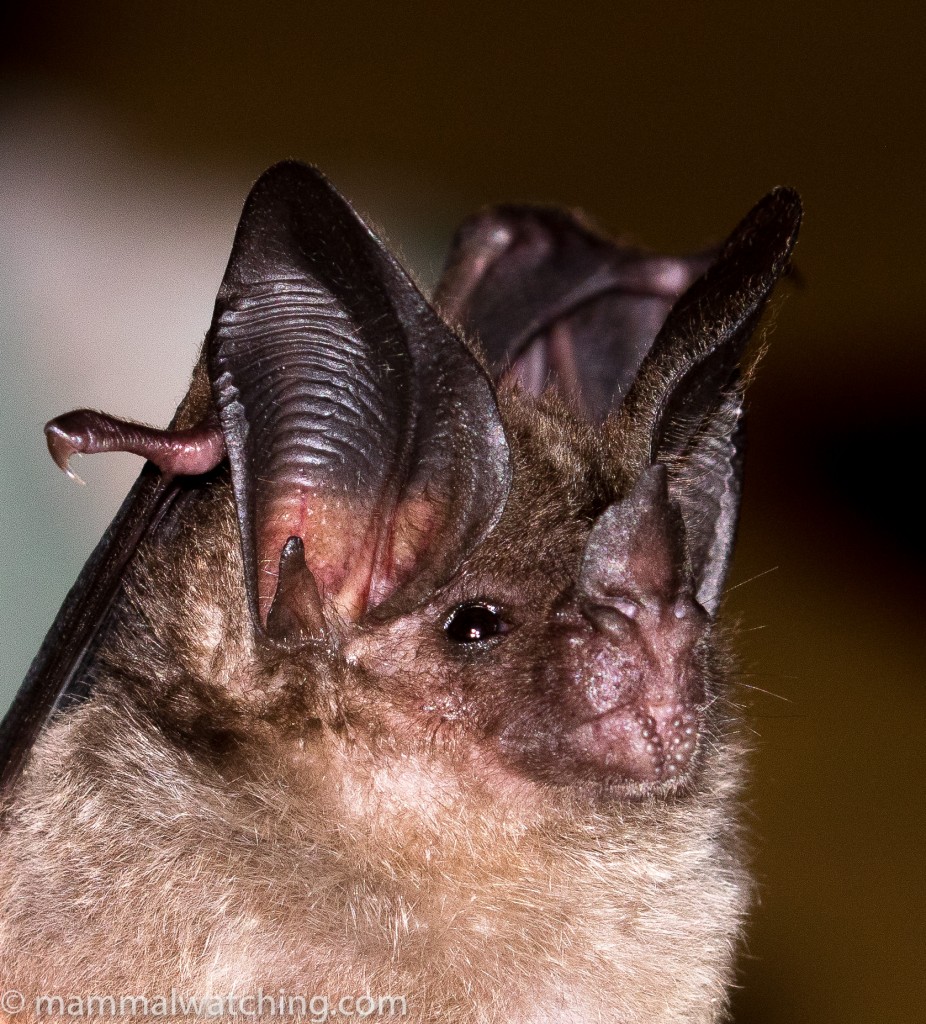
Southern Stripe-headed Round-eared Bat, Tonatia maresi
and a White-bellied Big-eared Bat.
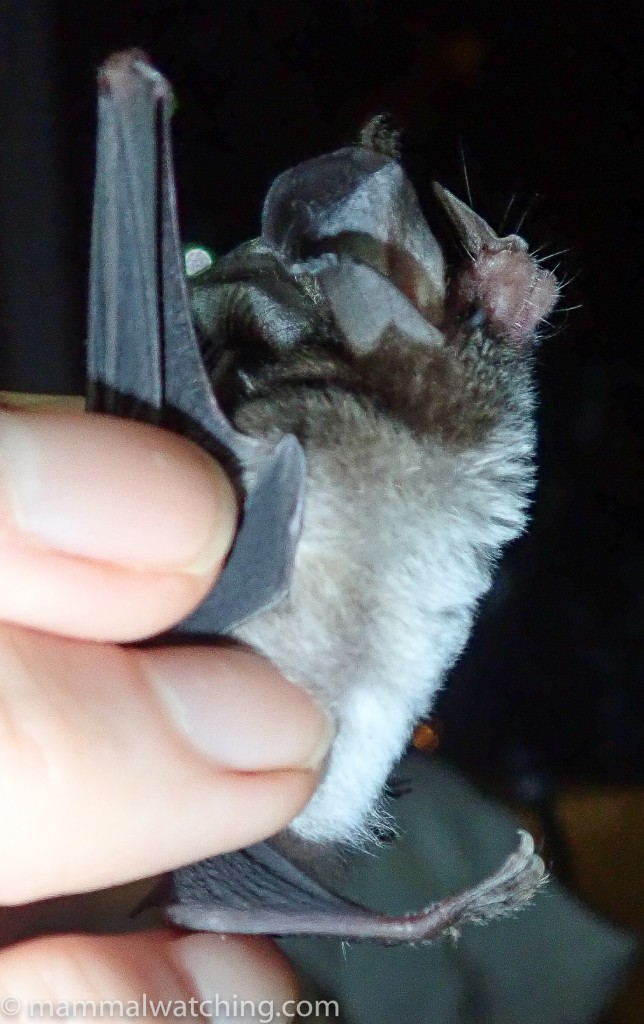
White-bellied Big-eared Bat, Micronycteris minuta
Rio Madeira
Back on the Madeira’s white water we wanted to spend the next few days exploring several sites, primarily on the left bank of the river that ought to be home to some restricted range primates that don’t occur along the Aripuana, including the beautiful Red-bellied Tamarin.
10 October. The small community of Sao Jose, on the right bank of the Madeira, was our first stop. The village is on the edge of varzia forest that is home to Pygmy Marmosets (a likely split from the species further west). We saw several trees that had recently been used for feeding, and found very fresh Jaguar prints, But heavy rain set in after an hour and the only mammals that morning were Brown Capuchins some roosting Greater White-lined and Greater Spear-nosed Bats and a Long-tongued bat species. Some of the crew spotted a Tayra near the village as they were walking back to the boat ahead of us.
The rain had cleared by the afternoon and we crossed to the left bank of the river to explore the forest around the tiny settlement of Matamata. This area is an “extractive reserve” which, broadly speaking, means the local people are allowed to live within the reserve and sustainably harvest some of the natural resources. These reserves can be diffiicult to access and Micah had spent considerable effort in arranging permits for us.
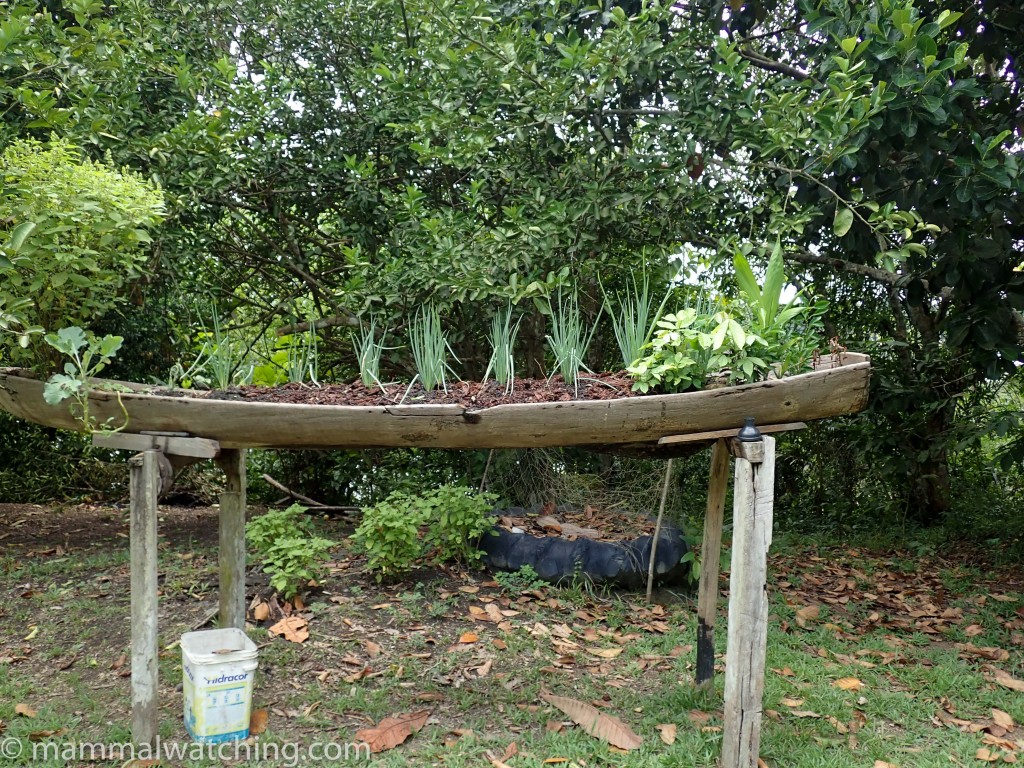
Though the forest around Matamata looked good, the wildlife was, once again, quite hard to find. Perhaps not a total surprise given that the local guide who accompanied us bought along his rifle in case he wished to do a little “extractive” shooting!
Though the locals confirmed they often saw Red-bellied Tamarins in the area we only saw a few Golden-backed Squirrel Monkeys and a few Lesser Dog-like Bats roosting on a tree.
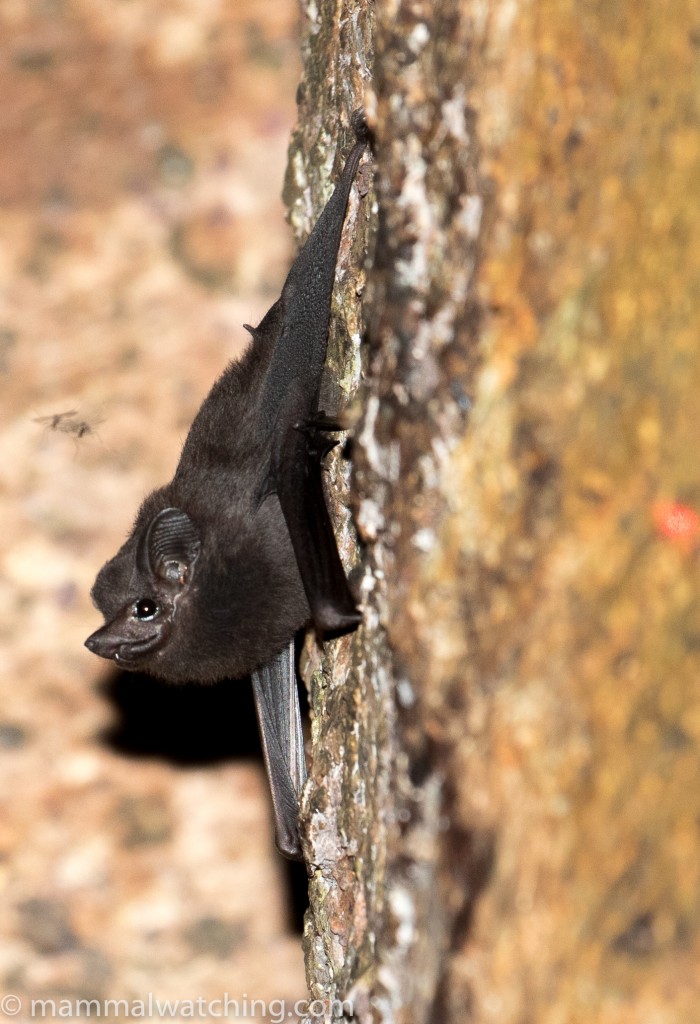
Lesser Dog-like Bat, Peropteryx macrotis
In a village house we were shown some molossid bats roosting between the carpentry. Almost impossible to photograph but I glimpsed the face of one clearly enough to identify them as Cinnamon Dog-faced Bats.
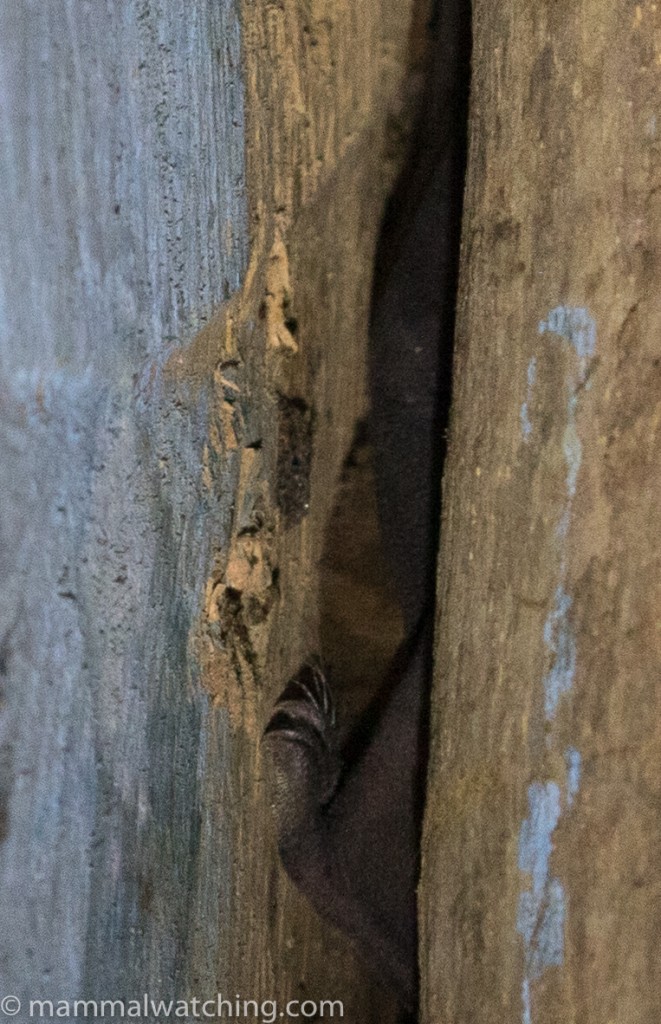
Cinnamon Dog-faced Bat, Cynomops abrasus. Truly!
Batting that evening was quite productive with mainly common species including Benkeith’s and Seba’s Short-tailed Bats,
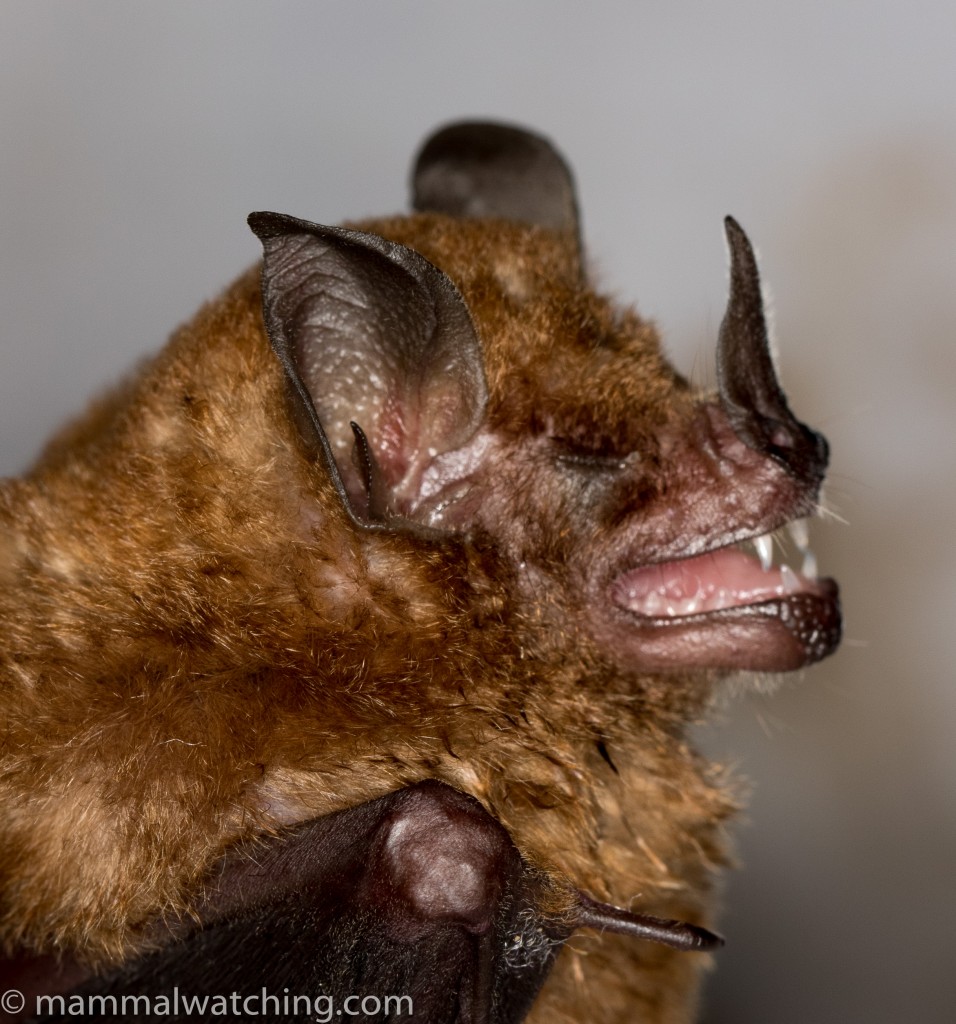
Benkeith’s Short-tailed Bat, Carollia benkeithi
Lesser Spear-nosed Bats and a Great Fruit-eating Bat.
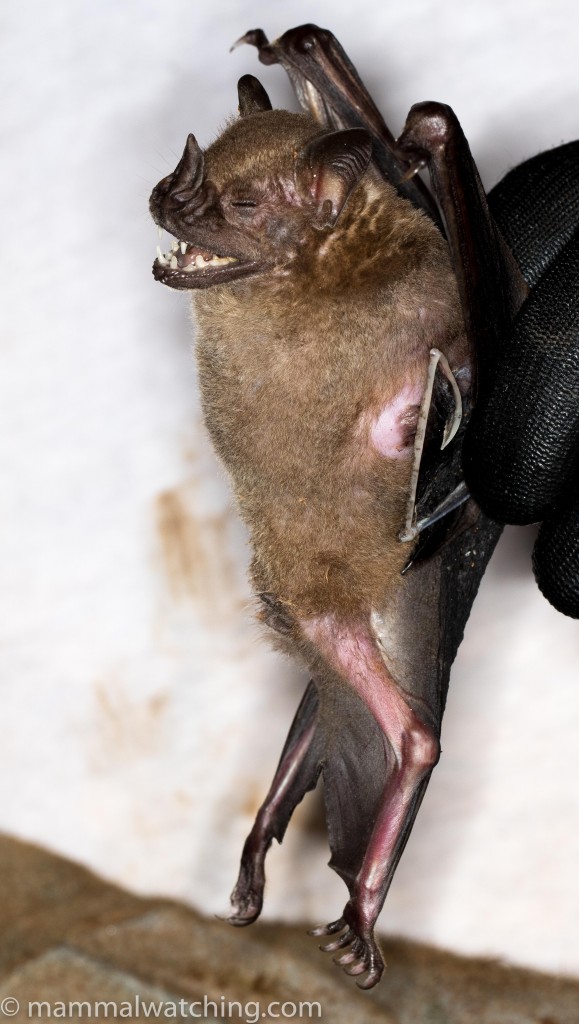
Great Fruit-eating Bat, Artibeus lituratus
Less common, at least it was a lifer for me, was a tiny Bidentate Yelow-eared Bat.
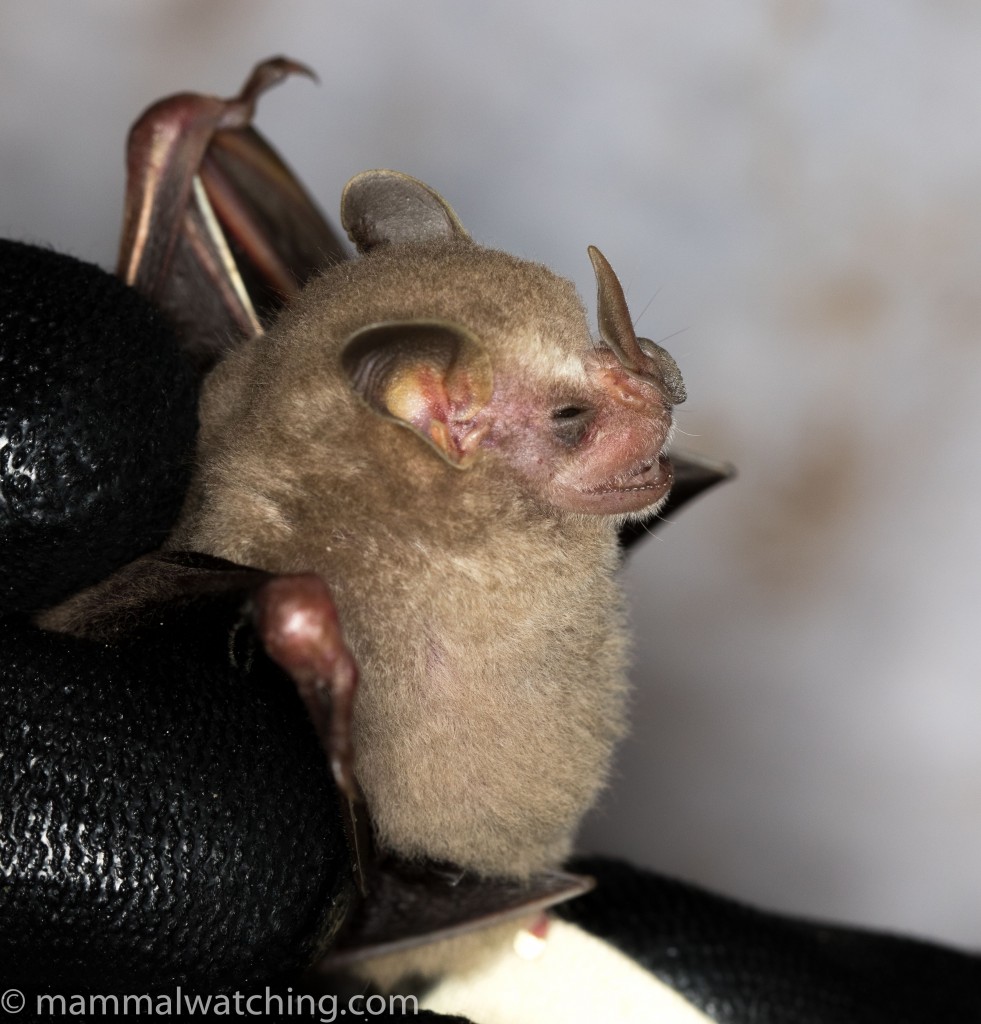
Bidentate Yellow-eared Bat, Vampyriscus bidens
11 October. We were back in the same forest the next morning. A long walk produced no primates, though we heard a troop at the very end that may have been the tamarins. Though we dipped on the monkeys we found some roosting Greater White-lined Bats and two Northern Little Yellow-eared Bats in a tent.
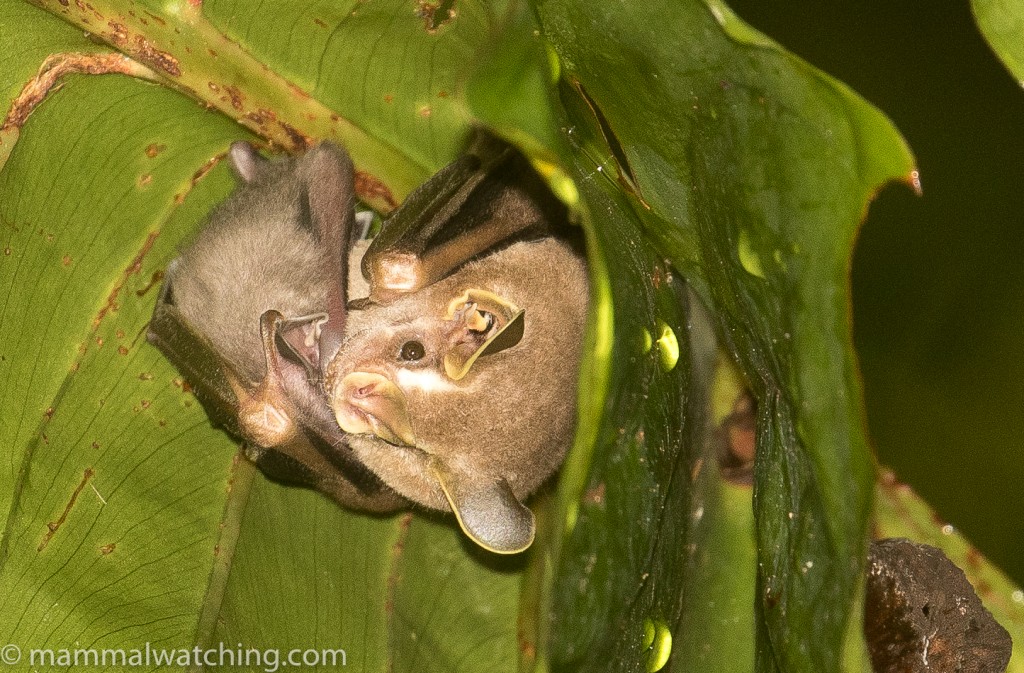
Northern Little Yellow-eared Bat, Vampyressa thyone
Some of the bugs were photo-worthy including this strange Wax-tailed Hopper.
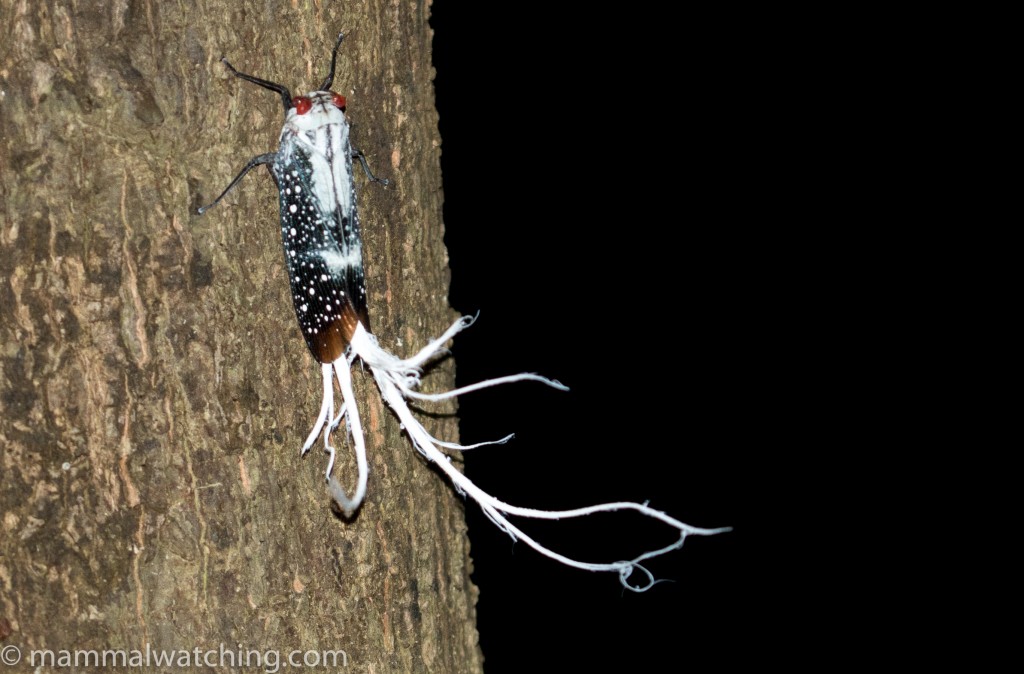
Wax-tailed Hopper
And one of the thermal scopes found the backside of a Amazonian Long-tailed Porcupine.
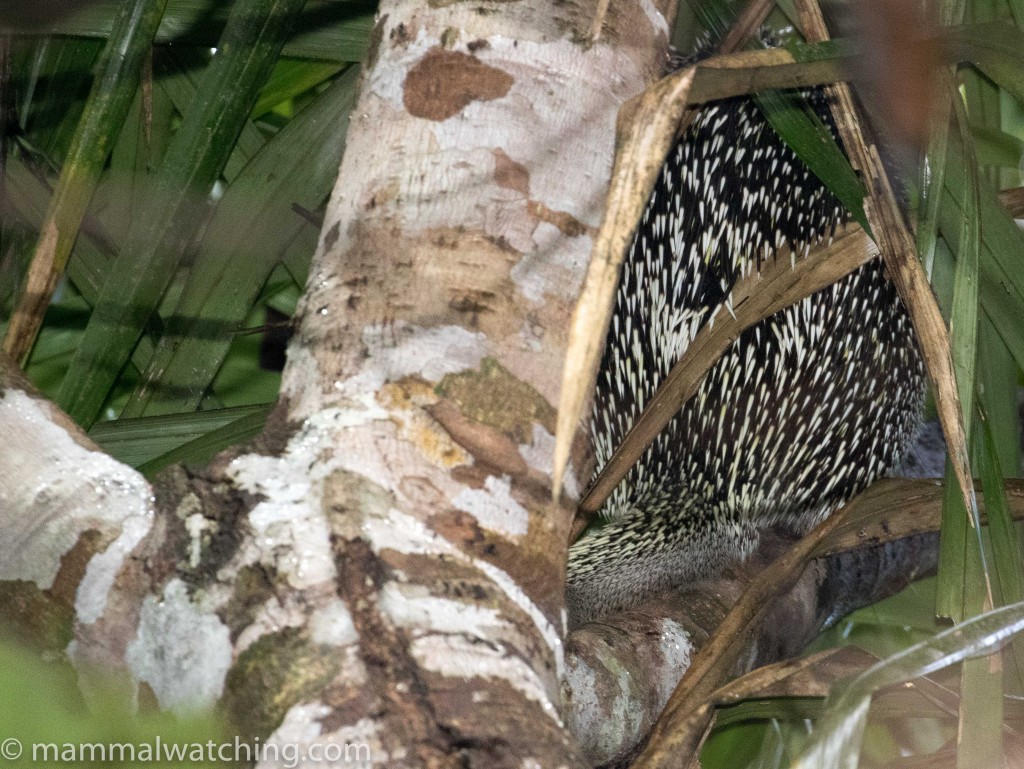
Amazonian Long-tailed Porcupine, Coendou longicaudatus
We were further along the river that evening opposite Borba. A short spotlighting trip in the canoes produced a Common Opossum, a few ghost bats (Diclidurus sp.) flying high overhead and both Greater and Lesser Fishing Bats skimming the water in good numbers.
12 October. The next morning we were in the same area which is reputedly good for the Red-bellied Tamarins. But despite another long, hot, walk, the only mammal of note was the Brown-throated Three-toed Sloth we spotted at the trail head.
There was yet more rain in the afternoon so we moved downriver and arrived at the next site, Igarape Luci, after dark. Fiona and Marcelo nobly volunteered to do some pre-dawn bat catching from about 3 a.m.
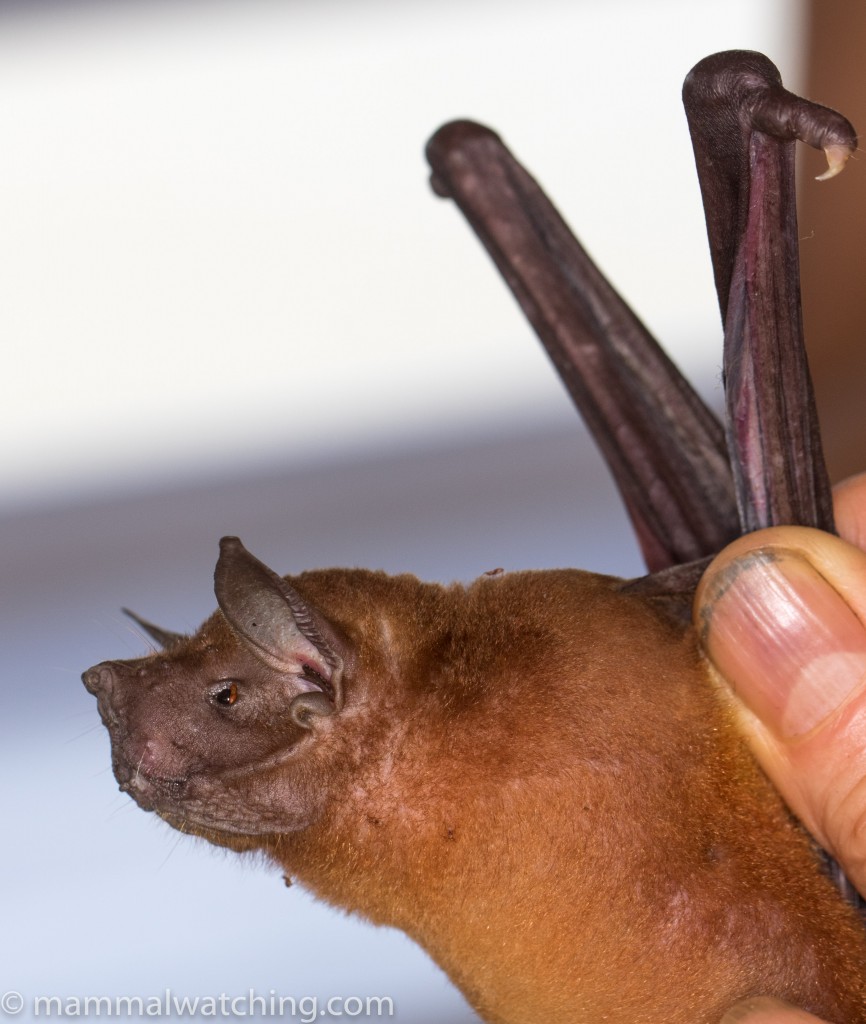
Greater Fishing Bat, Noctilio leporinus
13 October. We joined Fiona and Marcelo on the bank at dawn and they had an impressive haul of bats. Indeed this was probably the most successful netting session of the trip.
This Greater Fishing Bat (above) was an impressive beast which dwarfed the tiny Silver-tipped Myotis (below).
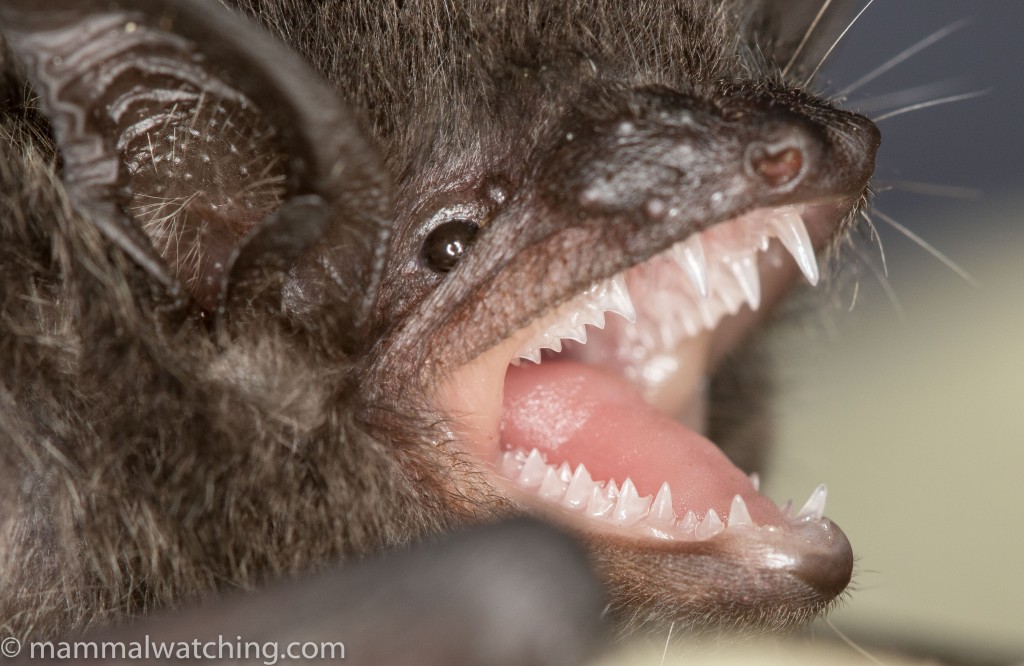
Silver-tipped Myotis, Myotis albescens
And we were able to contrast two very similar small dermanura bats side by side: Gervais’s and Gnome Fruit-eating Bats.
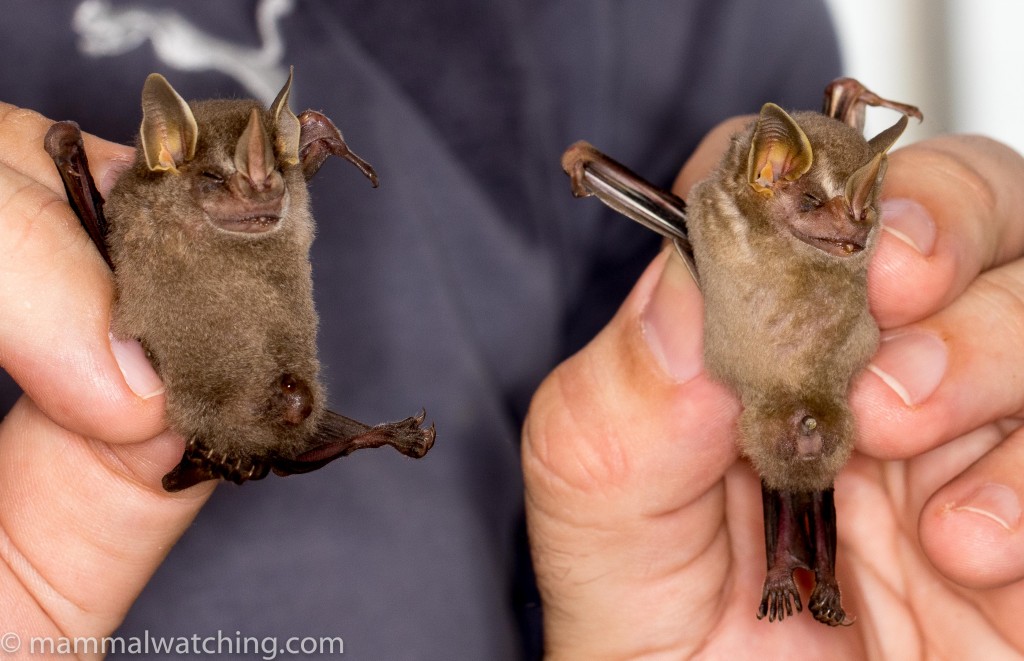
Gervais’s and Gnome Fruit-eating Bats, Dermanura cinerea and Dermanura gnoma
But best of all was a White-winged Dog-like Bat, a lifer for me. Fiona had caught one in the net and we found a few animals roosting in a hollow log a few meters away.
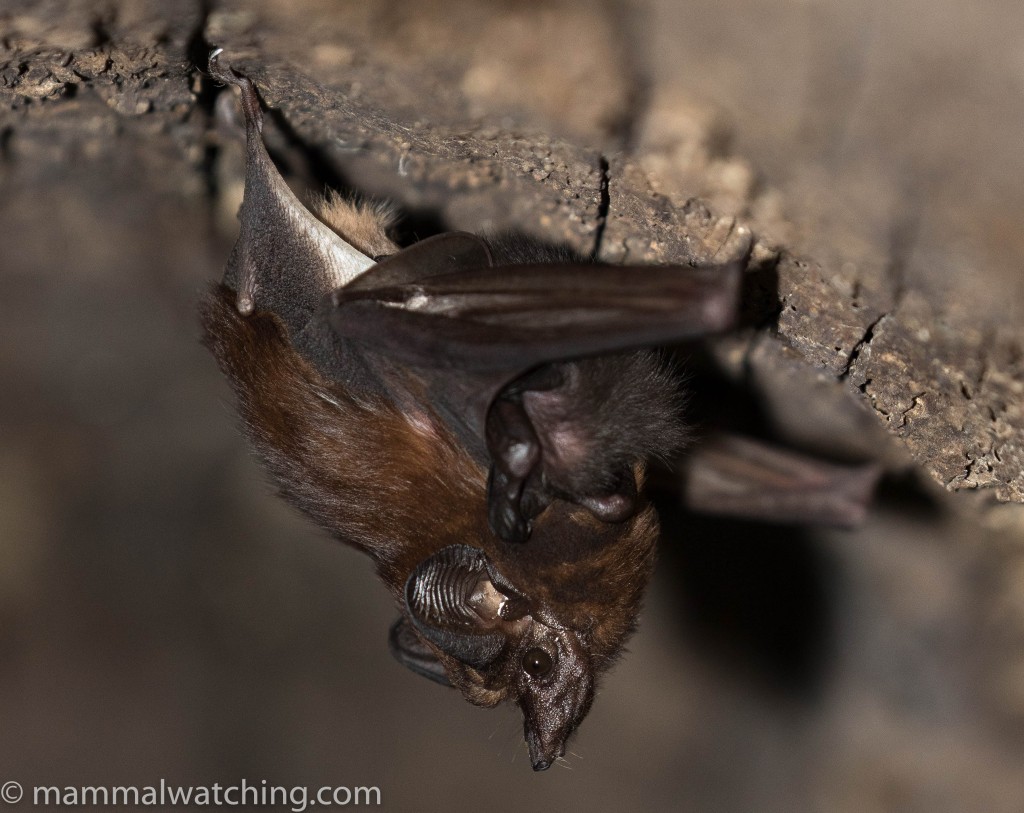
White-winged Dog-like Bat, Peropteryx leucoptera
The pale, translucent, wings are distinctive in this species.
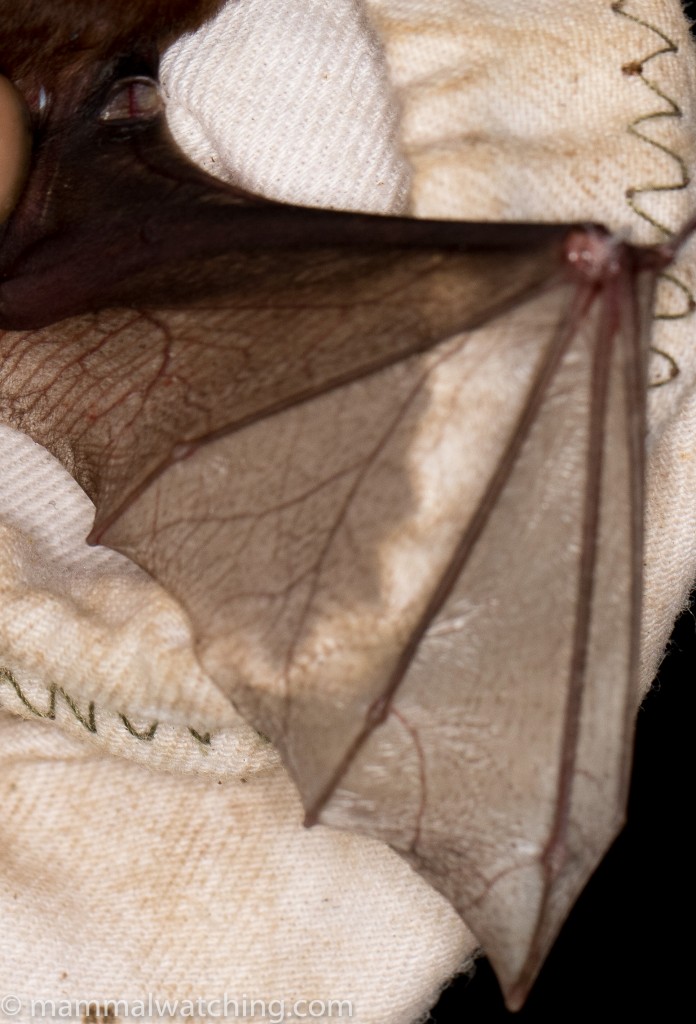
White-winged Dog-like Bat, Peropteryx leucoptera
Once we finished the bat show and tell, we took a short, productive walk, featuring a Brown-throated Three Toed Sloth and some rather shy, and very localized, Lake Baptista Titi Monkeys. A troop of Gold and White Marmosets were more confiding and put on quite a show in – for once – great light.
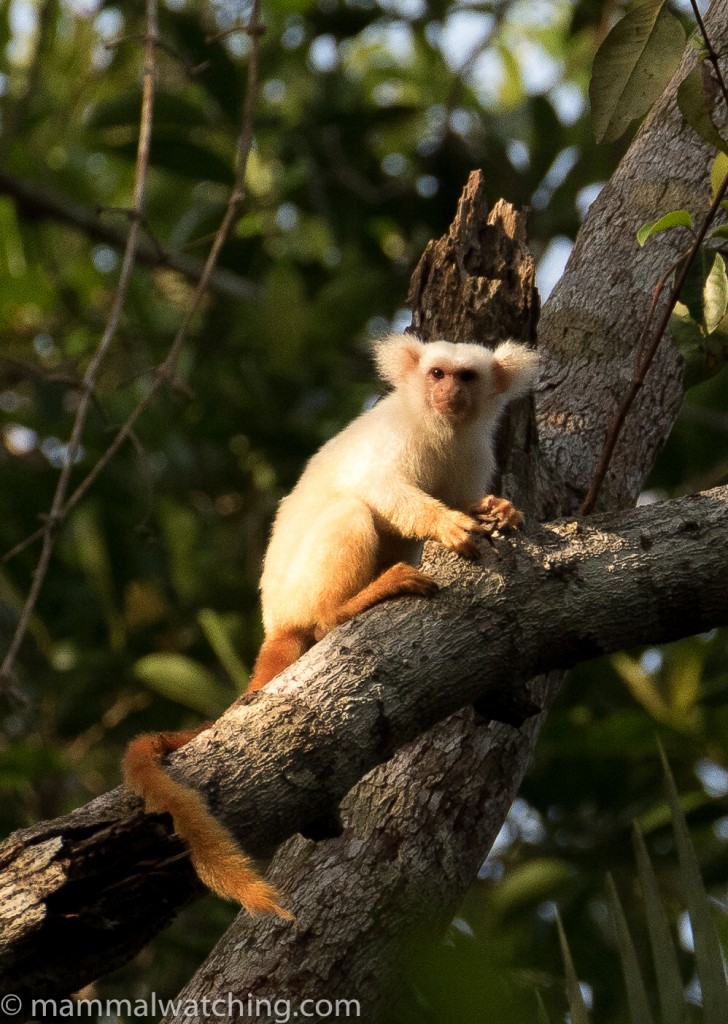
Gold and White Marmoset, Mico chrysoleuco
We heard Black Howler Monkeys calling and saw another troop of Brown Capuchins.
A spotlighting walk along a road that evening was less productive. The only mammals of note were the night monkeys we heard calling, though they were determined to remain hidden.
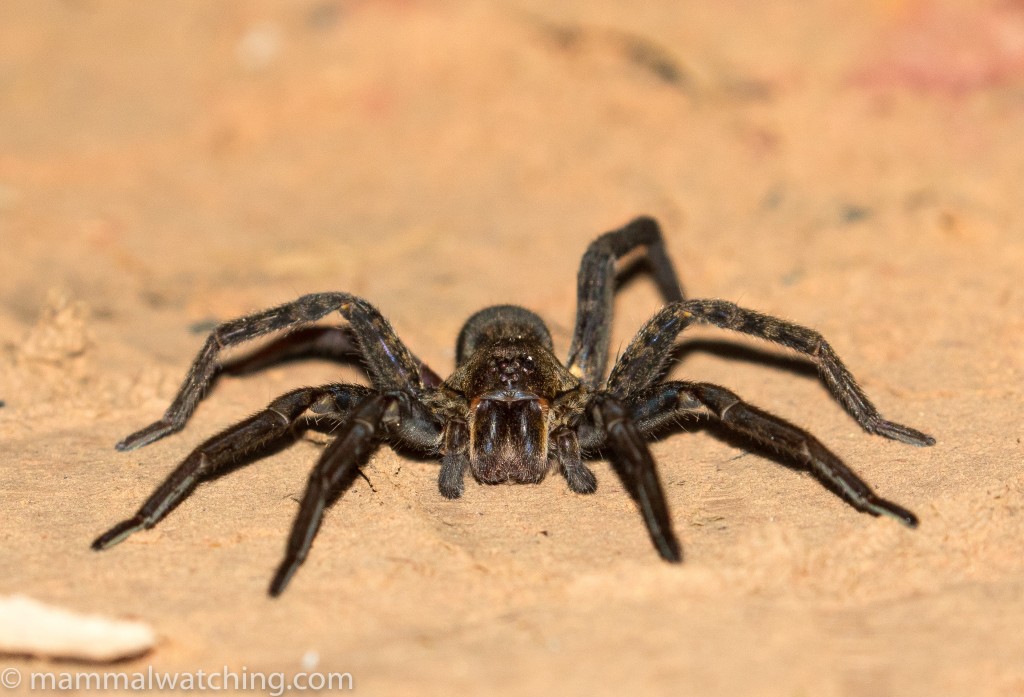
Wandering Spider species
Batting was again quite good that night, with several new species for the trip including Dwarf and Fischer’s Little Fruit Bats.
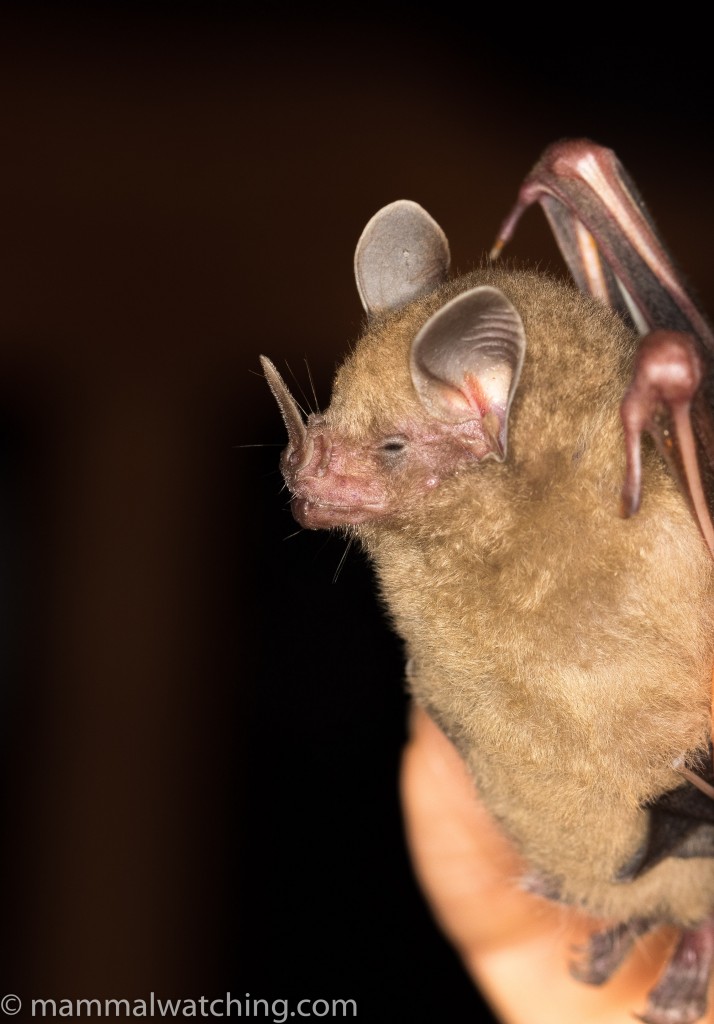
Fischer’s Little Fruit Bat, Rhinophylla fischerae
and a very cool looking Striped Hairy-nosed Bat.
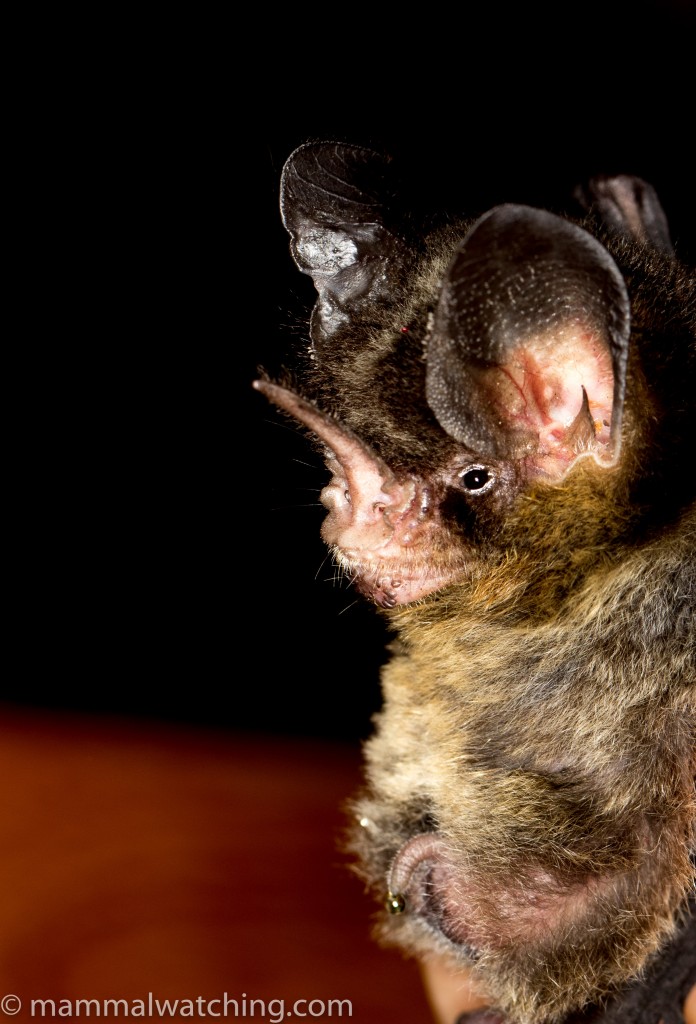
Striped Hairy-nosed Bat, Gardnerycteris crenulatum
as well as several other commoner species.
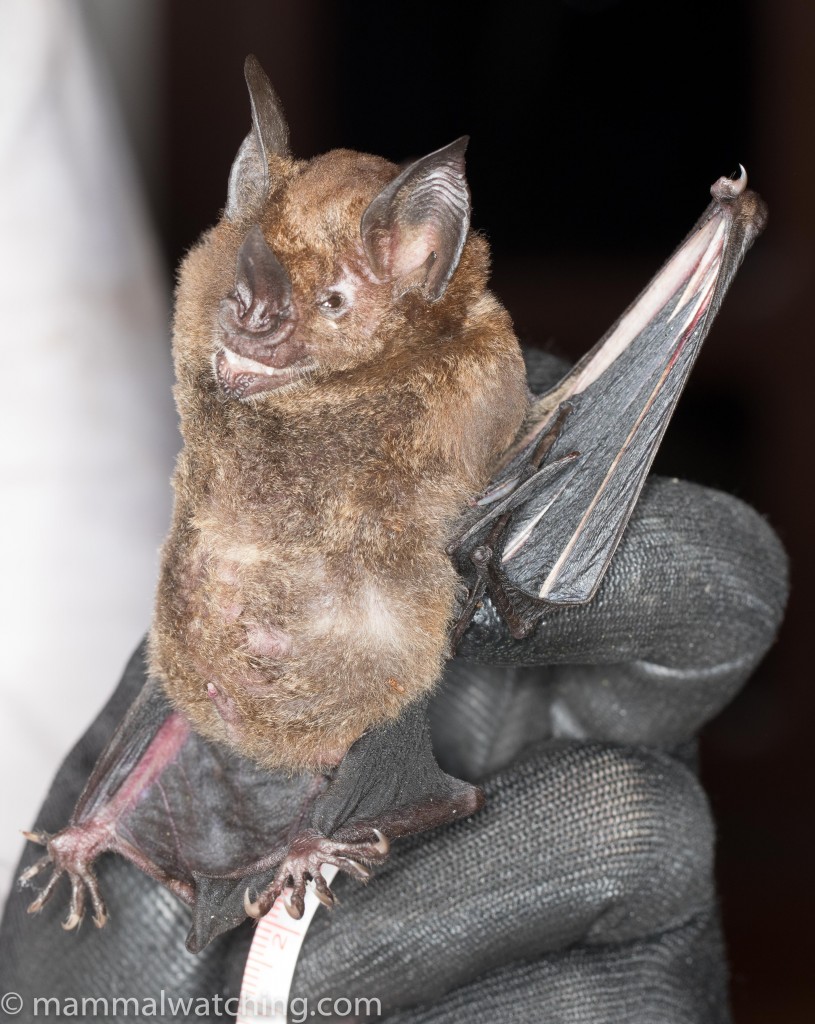
Lesser Spear-nosed Bat, Phyllostomus elongatus
The Amazon
Our last three days were spent heading back towards, and beyond, Manaus.
14 October. A morning walk on the north bank of the Amazon at Miracaueira, close to the confluence with the Rio Madeira, produced some Brown Capuchins and Golden-backed Squirrel Monkeys. We again heard howlers but couldn’t get close enough to see them. At this point some of the group gave into their latent birding genes.
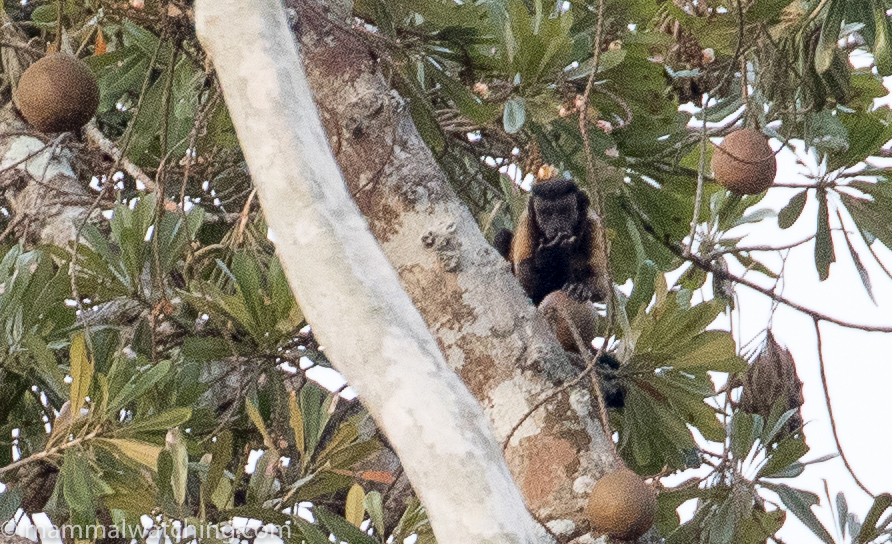
Brown-tufted Capuchin, Sapajus apella
We continued down the Amazon and pulled up at an island in the late afternoon where we hoped the batting could be productive and where we might find some of the impressively large amazonian rat species that we had missed so far.
During a short afternoon excursion onto the island Fiona found a roost of Frosted White-lined Bats and we saw a Three-toed Sloth. Perhaps the same sloth that we discovered injured on the ground later that night.
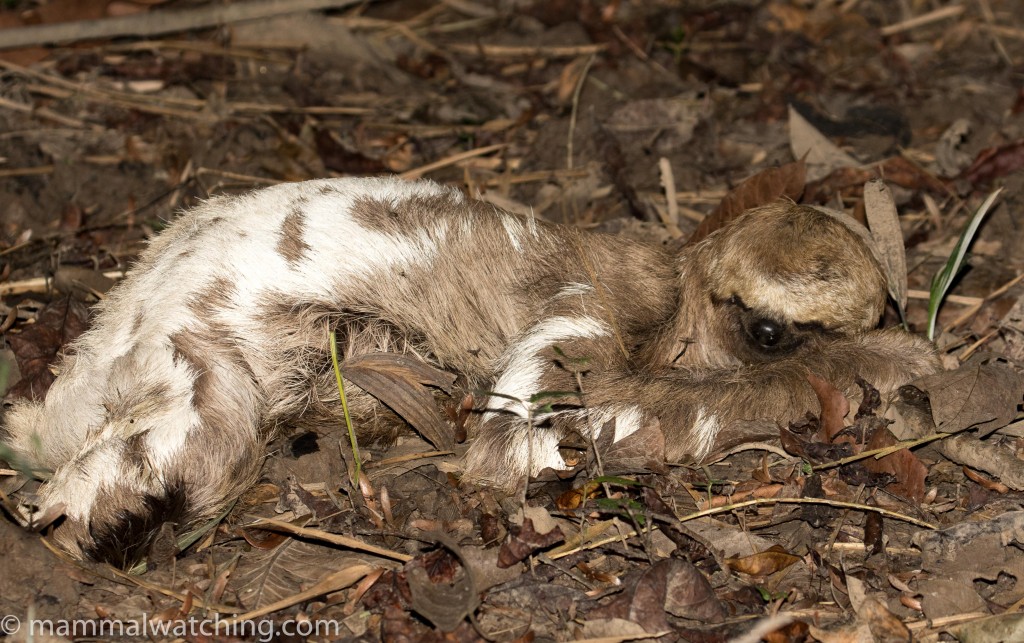
Brown-throated Three-toed Sloth, Bradypus variegatus
The night walk produced good views of several chunky Giant Tree Rats, with our thermal scopes again proving invaluable in locating them. But although we could hear Amazon Bamboo Rats calling we couldn’t see them.
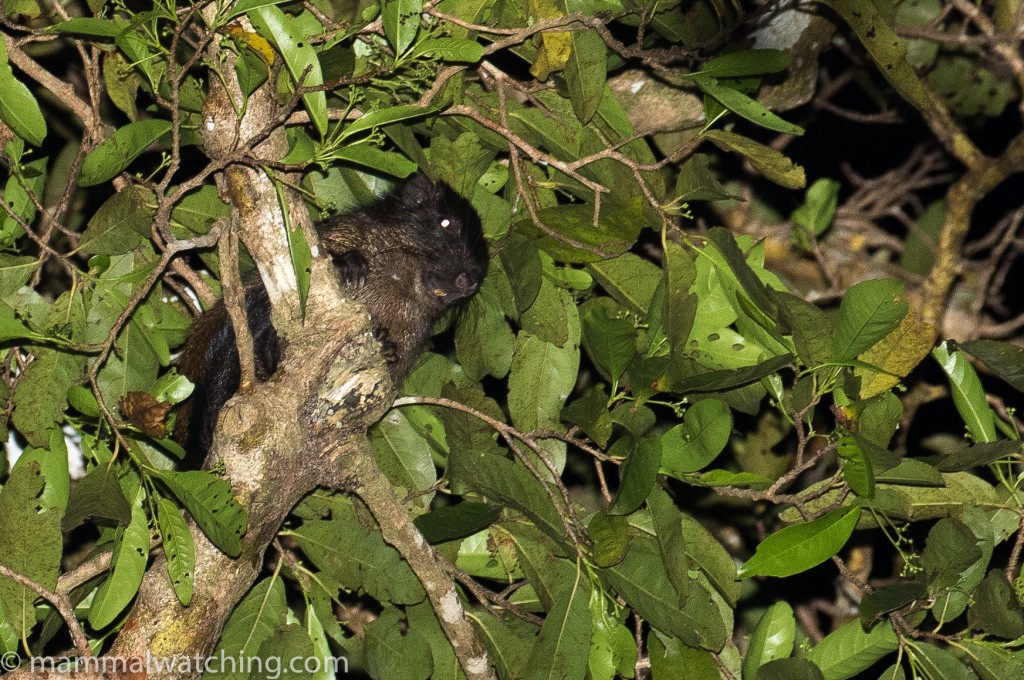
Giant Tree Rat, Toromys grandis
Marcelo set up some bat nets, and caught several Flat-faced Fruit-eating Bats and not much else.
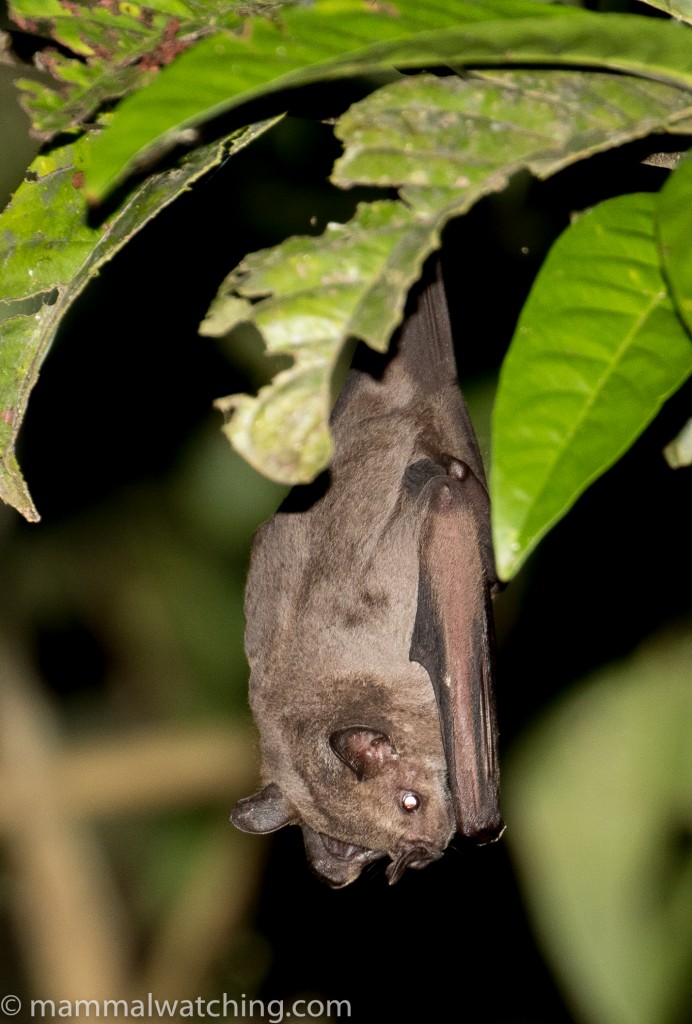
Flat-faced Fruit-eating Bat, Artibeus planisrostris
15 October. We steamed up the Amazon, back through Manaus, stopping briefly at the Wedding Of The Waters, where the Rios Solimoes and Negros meet to form the “proper” Amazon River itself. Sadly tourists are no longer allowed to jump in and fully appreciate the several degrees of temperature differential between the two streams of water.
More rain in the afternoon curtailed our plans yet again so we pressed on up the Rio Negro to a small reserve. An evening spotlighting there was good with several Red-nosed Tree Rats, including an extraordinary encounter with one animal that we first spotted half way up a tree. Fiona and I started squeaking to attract its attention – in the hope of a better pose for a photograph – and the animal immediately clambered down the tree, walked straight towards us all and stood on my and Fiona’s boots before realizing something wasn’t quite right! Fiona thought perhaps she was a mother with young. Or maybe my squeaking is irresistible. But it was the highlight of my trip.
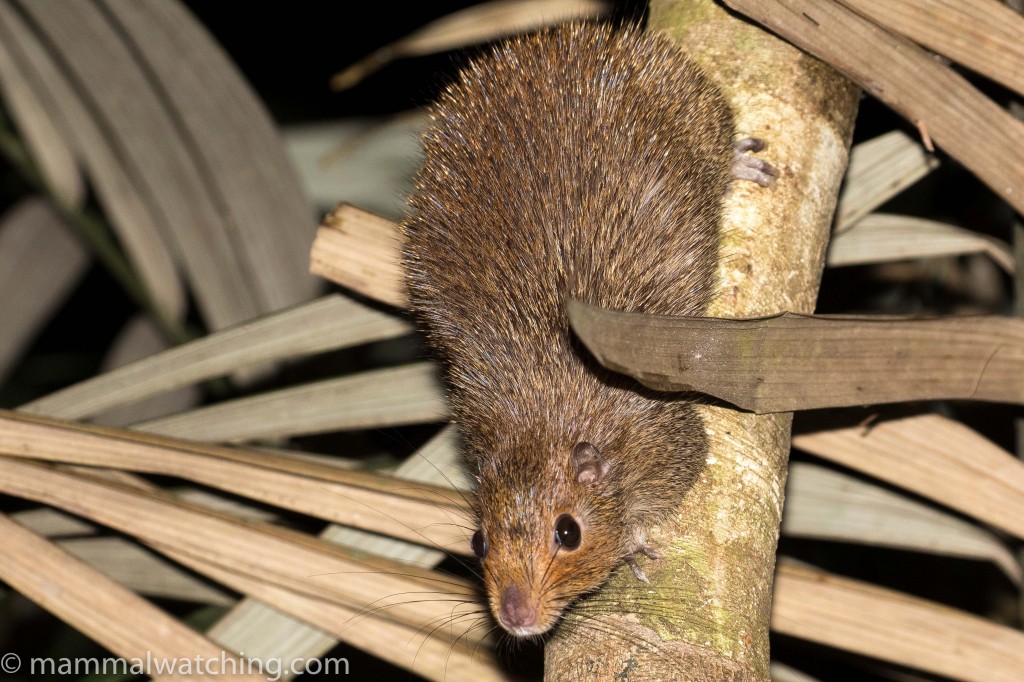
Red-nosed Armored Tree Rat, Makalata didelphoides
Most of the group also ended the walk with a good look at a Grey Four-eyed Opossum.
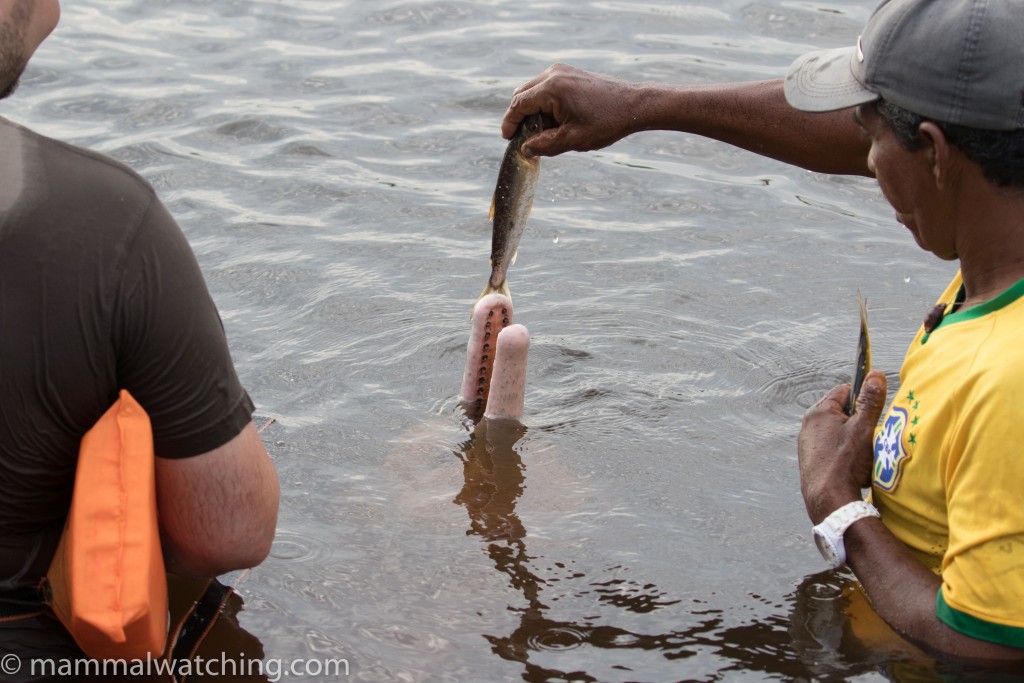
16 October. Our last day started in style, feeding Botos at a floating platform north of Manaus. Another highlight of the trip for many of us.
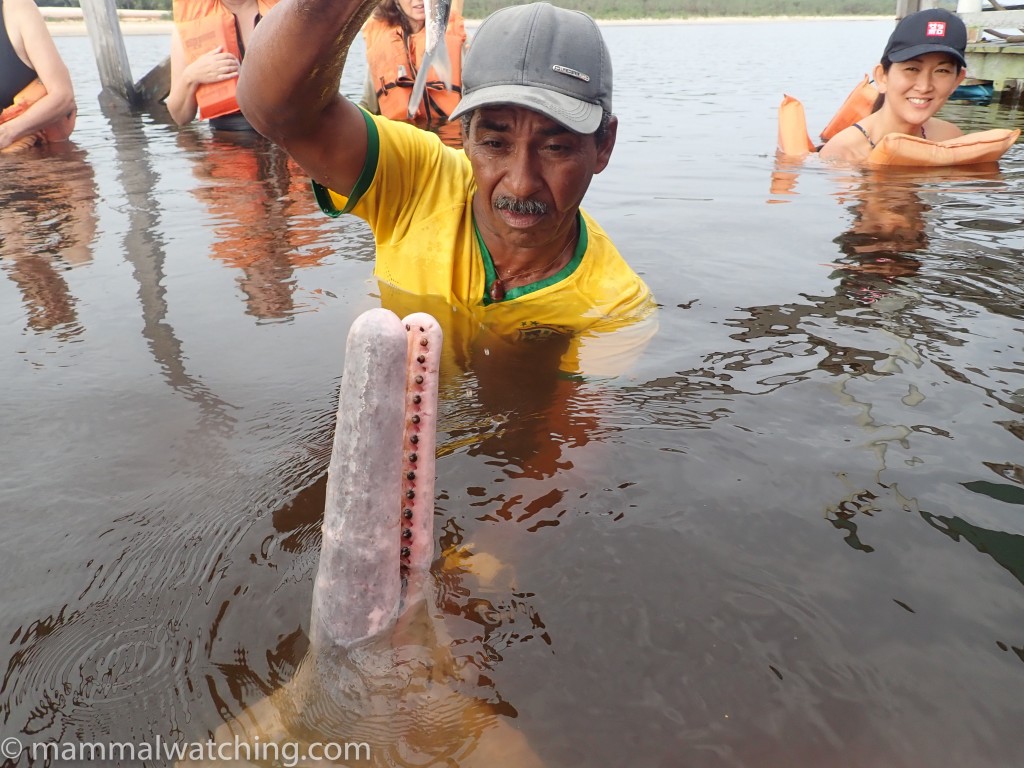
Patrick and I jumped ship in order to catch a flight back to the USA, motoring past the only Common (Humboldt’s) Squirrel Monkeys of the trip near an abandoned hotel. The rest of the group saw the same animals a little later during a last morning in the canoes before they cruised back to Manaus, dinner and the airport.
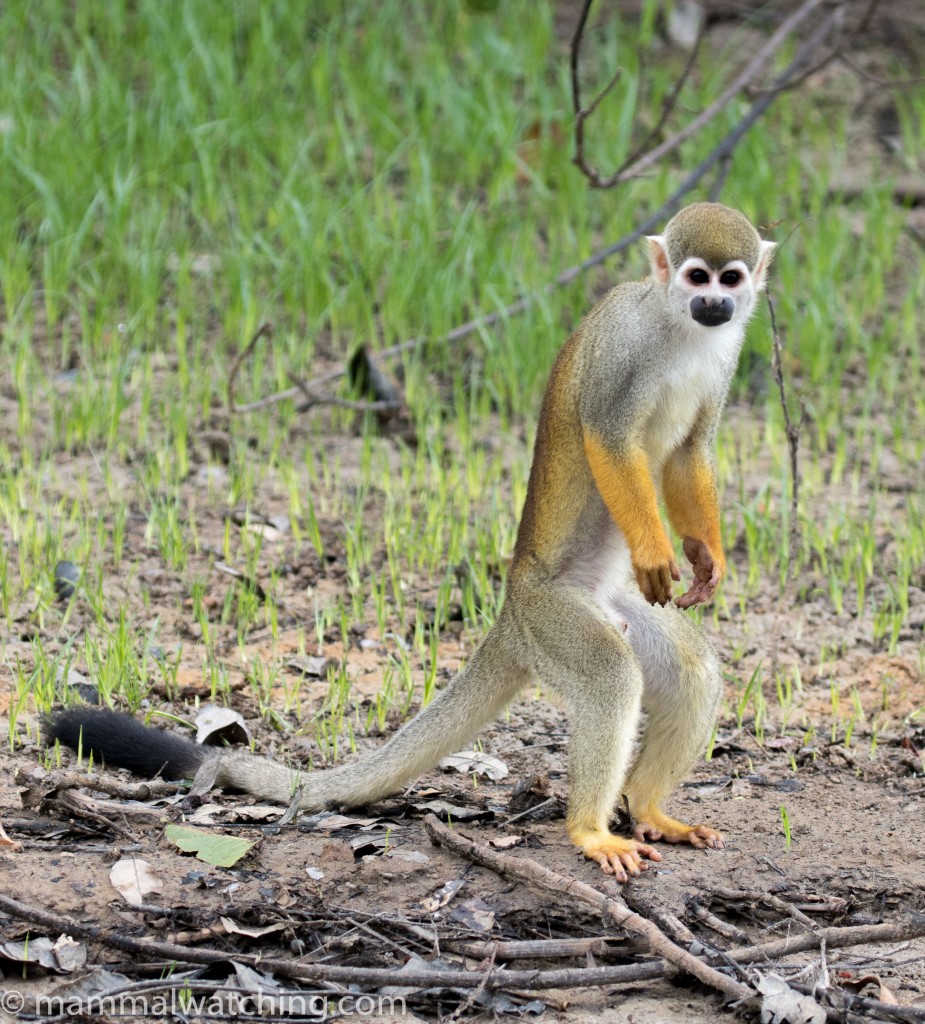
Humboldt’s Squirrel Monkey, Saimiri sciureus cassiquiarensis
Despite all the rain and the low water levels, life on the Amazon is never dull and we managed to see almost 60 mammal species, even if we missed several of our target primates and the manatee. The batting was also not as stellar as I had hoped, in part because we lost several nights to rain. It was also much harder to find rodents this time around. Thankfully it is never hard to find excellent capirinhas and cold beer on the Tumbira, and the food was so good I suspect we all left the boat a few pounds heavier than when we boarded.
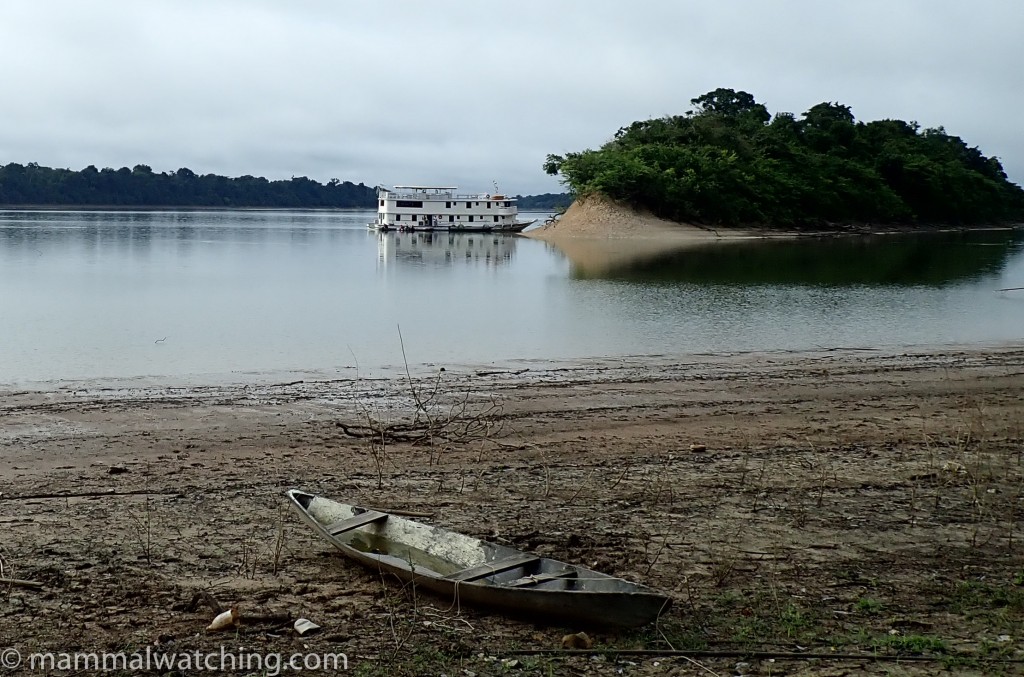
Thank you to the group for their flexibility in dealing with an ever changing itinerary and for helping to spot so many mammals, bugs, herps and birds. And a special thanks, of course, to Fiona, Micah and Marcelo for working so hard. Micah in particular must have averaged 18 hours a day. But even that level of exhausation wasn’t anything like enough to deter him from birding. We will have to try harder next time.
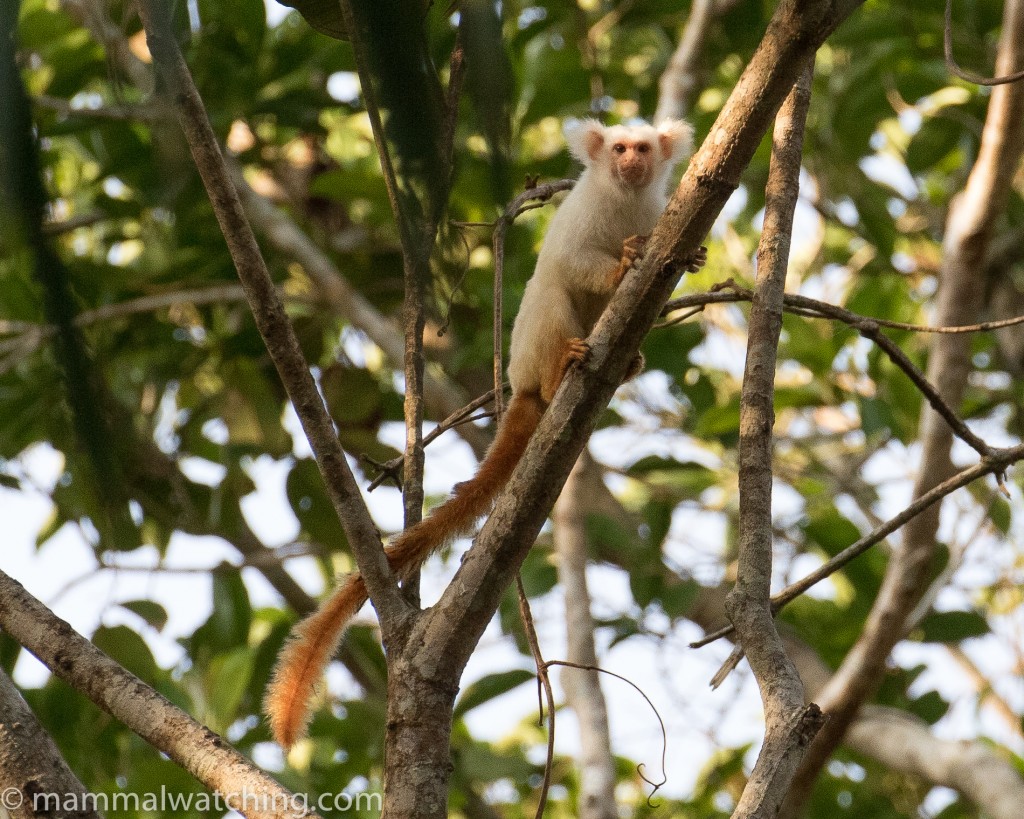
Gold and White Marmoset, Mico chrysoleuco
Trip List
Micah’s – more bird friendly – report of the trip is here.
Gray Four-eyed Opossum Philander opossum
Southern Opossum Didelphis marsupialis
Bare-tailed Woolly Opossum Caluromys philander
Southern Two-toed Sloth Choloepus didactylus
Brown-throated Three-toed Sloth Bradypus variegatus
Amazonian Long-tailed Porcupine Coendou longicaudatus
Black Agouti Dasyprocta fuliginosa
Neotropical Pygmy Squirrel Sciurillus pusillus
Giant Tree Rat Toromys grandis
Armored Tree Rat Makalata didelphoides
Proboscis Bat Rhynchonycteris naso
Frosted White-lined Bat Saccopteryx canescens
Greater White-lined Bat Saccopteryx bilineata
Chestnut Sac-winged Bat Cormura brevirostris
White-winged Dog-like Bat Peropteryx leucoptera
Greater Dog-like Bat Peropteryx kappleri
Lesser Dog-like Bat Peropteryx macrotis
Ghost Bat sp Diclidurus sp
Lesser Fishing Bat Noctilio albiventris
Greater Fishing Bat Noctilio leporinus
White-bellied Big-eared Bat Micronycteris minuta
Southern Stripe-headed Round-eared Bat Tonatia maresi
Striped Hairy-nosed Bat Gardenycteris crenulatum
Lesser Spear-nosed Bat Phyllostomus elongatus
Greater Spear-nosed Bat Phyllostomus hastatus
Baker’s Long-tongued Bat Glossophaga bakeri
Common Long-tongued Bat Glossophaga soricina
Silky Short-tailed Bat Carollia brevicauda
Ben Keith’s Short-tailed Bat Carollia benkeithi
Seba’s Short-tailed Bat Carollia perspicillata
Fischer’s Little Fruit Bat Rhinophylla fischerae
Dwarf Little Fruit Bat Rhinophylla pumilio
Common Tent-making Bat Uroderma bilobatum
Brown Tent-making Bat Uroderma magnirostrum
Short-headed Broad-nosed Bat Platyrrhinus brachycephalus
Bidentate Yellow-eared Bat Vampyressa bidens
Northern Yellow-eared Bat Vampyressa thyone
Great Fruit-eating Bat Artibeus lituratus
Dark Fruit-eating Bat Artibeus obscurus
Flat-faced Fruit-eating Bat Artibeus planirostris
Gervais’s Fruit-eating Bat Dermanura cinerea
Dwarf Fruit-eating Bat Dermanura gnoma
Cinnamon Dog-faced Bat Molossops abrasus
Silver-haired Myotis Myotis albescens
Pied Bare-faced Tamarin Saguinus bicolor
Gold-and-white Marmoset Callithrix chrysoleuca
Black-crowned Dwarf Marmoset Callibella humilis
Marca’s Marmoset Mico marcai
Common Squirrel Monkey Saimiri sciureus
Bare-eared Squirrel Monkey Saimiri ustus
Grey Woolly Monkey Lagothrix cana
Red-nosed Bearded Saki Chiropotes albinasus
Brown Tufted Capuchin Sapajus apella
Baptista Lake Titi Plecturocebus baptista
Prince Bernhard’s Titi Callicebus bernhardi
Ashy-black Titi Plecturocebus cinerascens
Tayra Eira barbara (crew only)
Amazon River Dolphin (Boto) Inia geoffrensis
Tucuxi Sotalia fluviatilis
59 species; seven of them lifers (in bold)



Leave a Reply
You must be logged in to post a comment.